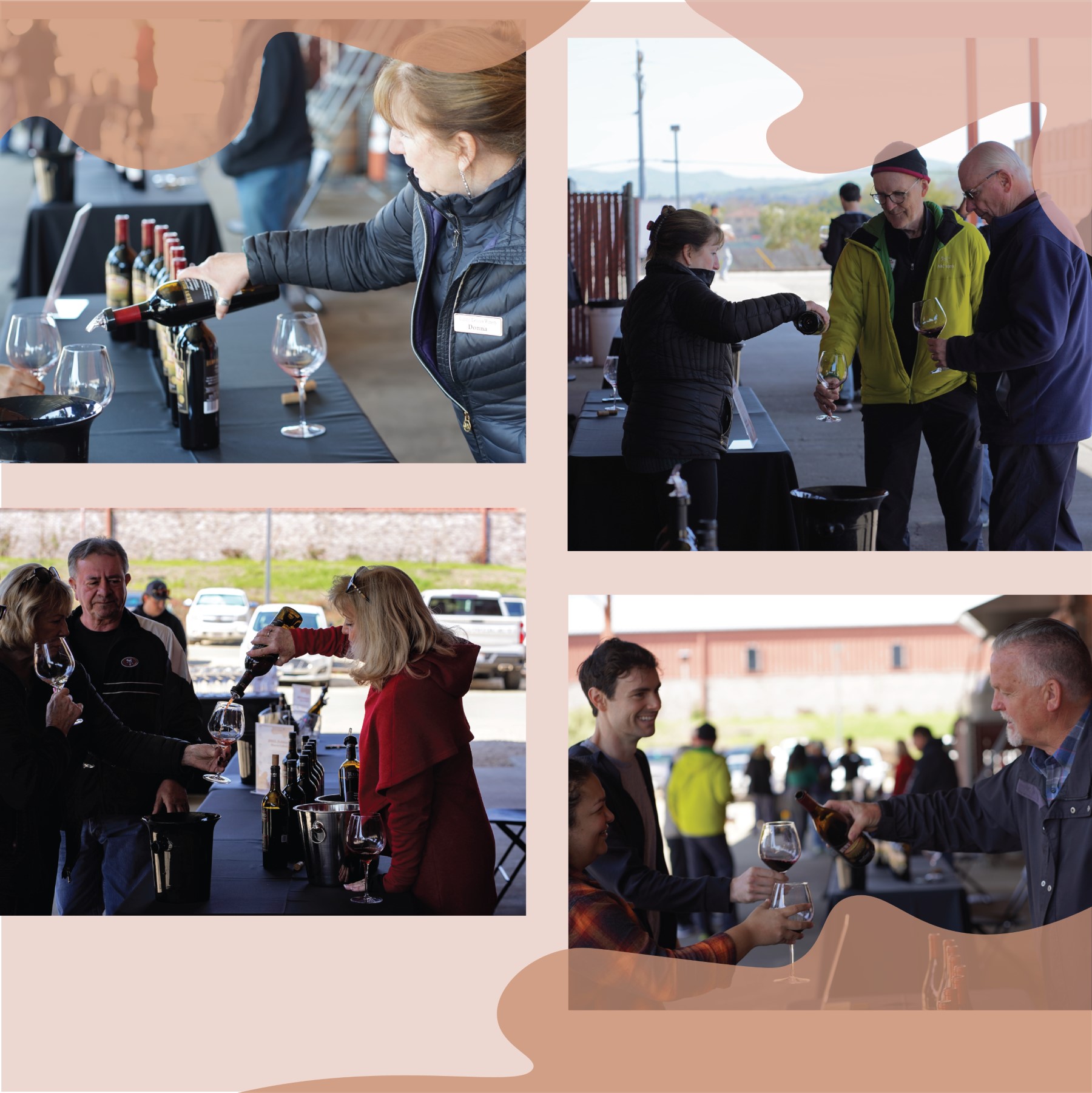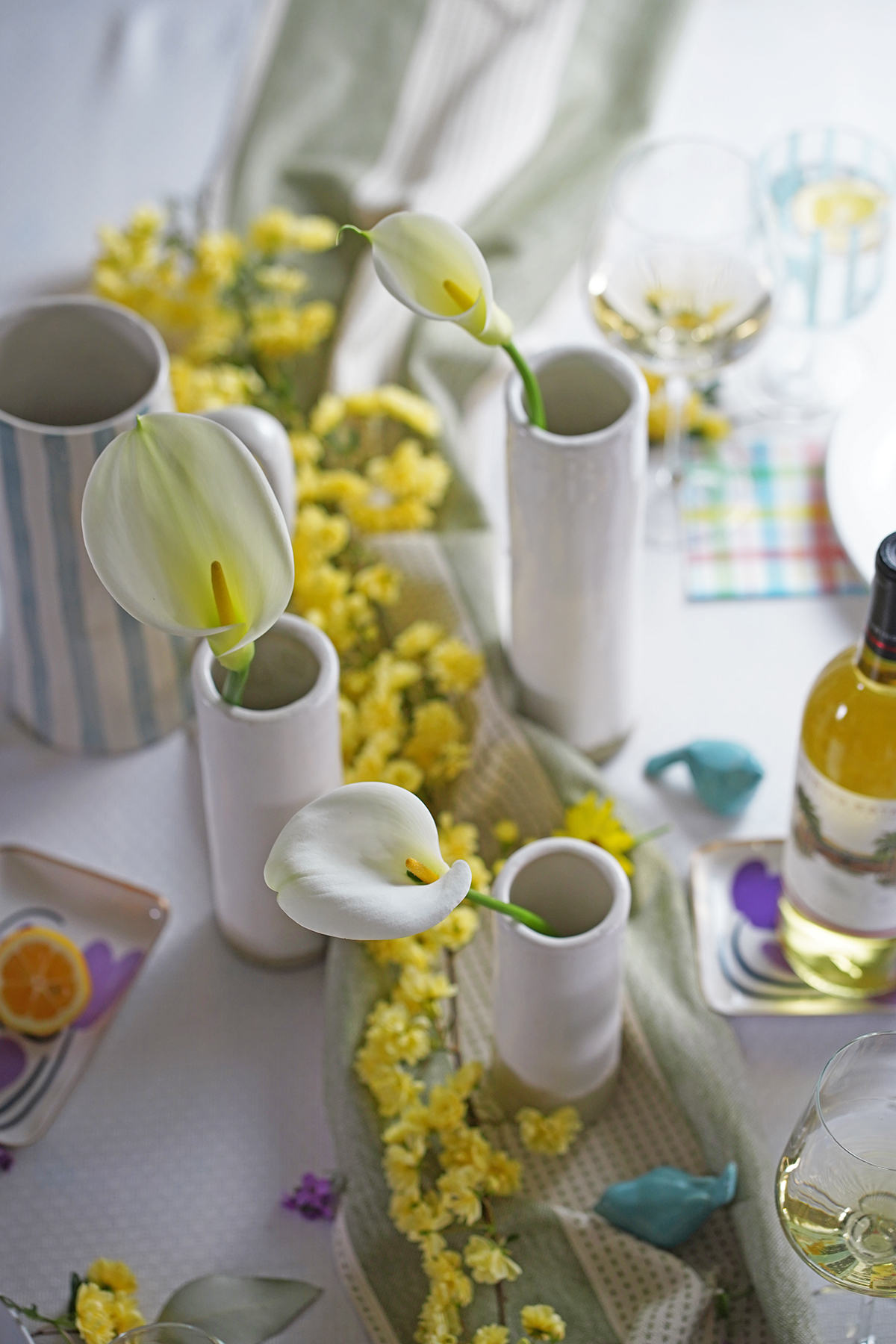Summer Berry Pie with Sparkling Moscato

We’re declaring that it’s a sweet treat summer. Inspired by the effervescent allure of our Moscato Dessert Wine, we wanted to make a dessert that feels perfect for July. While pie might not be the first thing on your list when you think of summer, it won’t take long for the enticing combination of summer fruit inside warm pastry to change your mind!
This recipe takes advantage of delicious late summer fruits, but feel free to get creative! We used strawberries and blueberries, and sealed it into our favorite whole-wheat pie crust for some extra dimension. Pop a chilled Moscato and let’s sip dessert & bake it too!
Late-Summer Mixed-Fruit Pie Recipe
By Stella Parks for Serious Eats
Ingredients
- 3 medium plums, apricots, or nectarines (about 12 ounces; 340g)
- 9 ounces pitted cherries (1 2/3 heaping cups; 255g), from about 12 ounces whole fruit (2 1/4 heaping cups; 340g)
- 6 ounces fresh blueberries, blackberries, or raspberries (1 cup; 170g)
- 4 ounces Cape gooseberries, currants, or fresh cranberries (1/2 cup; 110g)
- 7 ounces sugar (1 cup; 195g)
- 1/2 teaspoon (2g) kosher salt
- 1 1/2 ounces tapioca starch (1/3 cup plus 1 teaspoon; 40g)
- Favorite pie dough, rolled and chilled as per the directions for a double crust
- Sprinkling Sugar
Directions
For the Filling: Wash your stone fruit (no need to peel), cut into 1/2-inch slices, and measure out 9 ounces (1 1/2 cups; 255g) in a large bowl. Add pitted cherries, blueberries, and Cape gooseberries, or whatever mix of fruit you prefer, to bring the total weight to 28 ounces (790g; volume will vary). Toss with sugar, salt, and tapioca starch, folding with a flexible spatula until well combined. Scrape into a prepared pie shell and place the top crust in whatever configuration you prefer: a solid sheet, a lattice, a herringbone, or checkerboard. Trim away excess dough and refrigerate to ensure the top crust is completely chilled, about 30 minutes. Meanwhile, adjust oven rack to lower-middle position and preheat to 400°F (205°C).
To Bake: Place our chilled pie on a parchment-lined rimmed baking sheet. Bake until the crust is golden, about 1 hour, then loosely cover with tented foil. (Alternatively, an empty baking sheet can be placed on the topmost rack of the oven to serve as a shield.) Continue baking until filling is bubbling even in the very center of the pie, about 15 minutes more. If the crust completely covers the filling, bake until the pie reaches an internal temperature of 212°F (100°C) on a digital thermometer.
To Serve: Cool pie for at least 3 hours, depending on the type of pie plate. (Above that temperature, filling will be runny and thin.) Slice into wedges with a sharp knife, pressing firmly against bottom and sides of pie plate to ensure under-crust is completely cut.
Serve à la mode and with chilled sparkling Moscato for a perfect summertime treat!
Wine Acidity: A Fundamental Feature
 If you love exploring good wines like we do, your curiosity will lead you to all kinds of wine world vocabulary. In this blog, we’re exploring the essentials of wine acidity. What does “acidity” mean in wine tasting? Is acid in wine good or bad? How can you describe a wine’s acidity? We explore all this and more.
If you love exploring good wines like we do, your curiosity will lead you to all kinds of wine world vocabulary. In this blog, we’re exploring the essentials of wine acidity. What does “acidity” mean in wine tasting? Is acid in wine good or bad? How can you describe a wine’s acidity? We explore all this and more.
Acidity is Essential to Wine
There are four basic traits you can look for in every glass of wine: tannin, alcohol, sweetness, and acid. Of course, the levels and character of each of these elements will vary between varietals, vintages, winemakers, wine styles, terroir, and more. In general, you can expect red wines to be less acidic than white wines. Acidity is the main source of structure in a white wine, which is why it’s more associated with white wines. Red wines also have influential acidity, but their structure is generally dictated by the tannin quality. Light-bodied whites are generally more acidic than a more rounded white wine, and sweet white wines are the most acidic. A perfectly acidic wine will literally make your mouth water, sharpening the individual flavors, offering a delicious prickling sensation on the sides of the tongue, and a mouth-watering finish.
The Role of Acidity
Acid, in particular, is responsible for the tart, tangy, vibrant, or sour character within a wine. If it’s mouthwatering or makes you pucker a bit (good or bad) it’s probably the acidity at work. These fresh, tart and sour attributes of the wine are evaluated in relation to how well the acidity balances out the sweetness and bitter components of the wine such as tannins. Sweetness will temper the sensation of acidity--so two wines with the same level of acid won’t have the same sensation if one is sweeter than the other. Sweet wines generally have higher acidity because of this dynamic. Regardless of sweetness, however, a wine without acid ages poorly and tastes “flabby” and undefined. A wine that is very acidic but well balanced by its other elements is an absolute delight!
The Science of Wine Acidity
Depending on its acidity, the pH of wine ranges from 2.5 to about 4.5, making it less acidic than other common beverages like coke or lemonade. Tartaric and malic acid occur naturally in grapes, and as they ripen the sugar increases and the acid decreases. At harvest time, our winemaker makes picking decisions based on this balance. During the winemaking process, many wines will undergo malolactic fermentation (also called “the malo” or MLF), a secondary fermentation where malic acid is converted into the softer lactic acid creating the creamy or “buttery” profiles of wine. If you have ever compared a stainless steel Chardonnay (no MLF) to an oaked Chardonnay (MLF) you know that the type of acid in a wine has a significant impact on the flavor and profile of the wine.
Describing Wine Acidity
Other than simply “acidic,” a few words you may hear to describe acidity in a wine include tart, tangy, fresh, and sour. If you want to be more creative and describe the exact character of the acidity, words like puckering or mouthwatering describe the effect of the wine, while laser-sharp, crunchy, or crisp might encapsulate the effect on a wine’s structure. Feel free to borrow other acidic fruits to describe the individual notes, such as lemon zest, tangerine, or grapefruit in a white wine or cranberry and tart cherry in a red wine. Some words provide an overall description of how the wine feels, like racy, electric, zippy, zing, bright, or brisk, and these refer to the acidity as well.
Acidity and Wine Pairing
Outside of the characteristics of the wine itself, acidity also factors into a wine’s pairing potential. A wine with nice acidity will pair very nicely with delicious salty or higher-fat foods, perking up these heavier meals by working as palate cleansers and preparing you for each delectable bite. Additionally, a lower acid wine will taste dull and flat alongside acidic dishes, while a crisp, higher-acid wine will complement the meal beautifully. So, if you are having a dish that is zesty and zippy with acidity, you can choose a wine that matches. We recommend serving acid-driven wines at a lower temperature. Acid and chilling go hand in hand—it’s one thing that makes these wines so crisp and refreshing. Traditional Italian wines are well-known for their pairability, and it will come as no surprise that it’s due to their amazing acidity, so we recommend a zippy Sangiovese or a Barbera with tart cherry notes with dinner tonight!
Growing: An Estate Vineyard Update

As spring gives way to summer, we are out in the vineyard to look at all the glorious changes that the season has brought. Spring means a vibrantly green season, with verdant leaves, vines, and beautiful grape blossoms. Those blossoms quickly turn into green juvenile grapes, which will grow in size until veraison, when they reach their mature color. The vineyard is beginning the shift from blossom to early berry. Scroll through this gallery for a virtual walk through the vineyard with us!
 The sun is beaming into the vineyard, tickling the tops of the vines and illuminating the diligent growth of the past few months.
The sun is beaming into the vineyard, tickling the tops of the vines and illuminating the diligent growth of the past few months.

The rain of winter and spring has allowed our vines to clothe themselves in a dense canopy of leaves.
 These young Cabernet vines have bloomed beautifully and will self-pollinate. This early stage doesn’t last long, though!
These young Cabernet vines have bloomed beautifully and will self-pollinate. This early stage doesn’t last long, though!
 These Petite Sirah berries are also very early in their development, but you can see the individual definition of the berries.
These Petite Sirah berries are also very early in their development, but you can see the individual definition of the berries.
 Some vines, like this Sangiovese, offer a glimpse of the future. You can see the clusters taking shape.
Some vines, like this Sangiovese, offer a glimpse of the future. You can see the clusters taking shape.
 Of course, every vine has its own pace. These clusters are already heavy and growing fast.
Of course, every vine has its own pace. These clusters are already heavy and growing fast.
 The sunshine makes each block glow in the morning and ripen in its season. We are excited for this Sangiovese’s future.
The sunshine makes each block glow in the morning and ripen in its season. We are excited for this Sangiovese’s future.
 These baby Barbera bunches are looking positively dreamy in the morning sun!
These baby Barbera bunches are looking positively dreamy in the morning sun!
 As the season progresses, our vines will continue to grow and fill out each block of the vineyard with vibrant green.
As the season progresses, our vines will continue to grow and fill out each block of the vineyard with vibrant green.
 More than just grapevines, our estate is a full ecosystem. Come visit us to take in the beauty of the wildflowers, birds, trees, and blue skies!
More than just grapevines, our estate is a full ecosystem. Come visit us to take in the beauty of the wildflowers, birds, trees, and blue skies!
Strawberry & Salute Rosé Snack Cake
 This summer, we’re making a point to seek out all the little sweet treats. This Strawberry Rosé snack cake, with its beautiful pink hue and very light and fluffy texture, is perfect for those moments in the day when you want a little morsel of joy. Plus, this cake is easy to put together and is great for sharing, and since the alcohol content in the Rosé bakes off, anyone can enjoy it! The flowers are blooming all around us, the summer fruit is ripening, and it’s a Rosé kind of day, so this recipe is the perfect choice.
This summer, we’re making a point to seek out all the little sweet treats. This Strawberry Rosé snack cake, with its beautiful pink hue and very light and fluffy texture, is perfect for those moments in the day when you want a little morsel of joy. Plus, this cake is easy to put together and is great for sharing, and since the alcohol content in the Rosé bakes off, anyone can enjoy it! The flowers are blooming all around us, the summer fruit is ripening, and it’s a Rosé kind of day, so this recipe is the perfect choice.
Strawberry-Rosé Snack Cake
Ingredients
 Cake:
Cake:- 1 1/2 cups freeze-dried strawberries, divided
- 1 1/2 cups all-purpose flour
- 1 cup granulated sugar
- 2 teaspoons baking powder
- 1/2 teaspoon kosher salt
- 2/3 cup rosé wine
- 1/4 cup canola oil
- 1 teaspoon vanilla extract
- 1 large egg
- Frosting:
- 1/4 cup unsalted butter, softened
- 4 ounces cream cheese, softened
- 1/4 teaspoon kosher salt
- 2 1/4 cups powdered sugar
Directions
Prepare the Cake: Preheat oven to 350°F. Line an 8-inch square baking pan with parchment paper, leaving a 2-inch overhang on all sides. Process freeze-dried strawberries in a mini food processor until powdered, 30 seconds to 1 minute. Measure 3 tablespoons powdered strawberries into a medium bowl (reserve remaining powdered strawberries in the food processor for Frosting). Add flour, granulated sugar, baking powder, and salt to bowl. Using a spoon, make a well in center of flour mixture, and pour rosé wine, oil, and vanilla into well. Crack egg into rosé mixture. Pierce egg using tip of a whisk, and lightly beat together. Fold egg mixture into flour mixture to form a smooth batter.
Spread batter evenly in prepared baking pan. Bake in preheated oven until a wooden pick inserted in center comes out clean, 25 to 28 minutes. Remove from oven, and cool in pan 5 minutes. Using parchment paper overhang, lift Cake from pan and transfer to a wire rack. Cool completely, about 1 hour.
Prepare the Frosting: Place butter, cream cheese, and salt in a clean bowl, and beat with an electric mixer fitted with a paddle attachment on medium-high speed until smooth, about 1 minute. Add reserved powdered strawberries, and beat on medium-high speed until thoroughly combined, about 1 minute. Add powdered sugar, and beat on low speed until smooth and creamy, about 1 minute. Spread Frosting over cooled Cake. Enjoy!
We invite you to enjoy this cake with our Wine of the Month, Salute Rosé! On sale now for a limited time. 
Elevated Mimosas for Mother's Day

Mother’s Day is this Sunday, and we’re here to help you make it special. Classic Mimosas (or should we say Mom-osas) are a special treat for any day, but we think this is the perfect chance to elevate this simple libation! Below, we’ve suggested garnishes and add-ins of all kinds to make these Mimosas a signature staple. Even if you don’t celebrate Mother’s day, this is a guide to elevated mimosas in all seasons! Enjoy every kind of spin on these drinks, from sweet and fruity to tart and zesty, and step beyond mere OJ & bubbles.
Think Outside the Orange Juice
Mix and match any of these to create some unforgettable combos for your base!
Grapefruit Juice
Pear Puree
Pink Lemonade
Pineapple Juice
Watermelon Puree
Cranberry Juice
Make it a Magnificent Mixer
There’s no Sparkling Wine monopoly! Add a touch of these to the party:
Tequila
Peach Liqueur
Vodka
Grapefruit Sparkling Water (Non-Alcoholic option)
Small Scoop of Sherbet
Infuse Your Sip with Whole Fruit
Make a “berry” beautiful beverage when you mix and match these fruity delights!
Raspberries
Citrus Wedges
Blueberries
Mango Cubes
Tart Cherries
Pomegranate Arils
Kiwi Rounds
Jazz Your Glass With an Herbaceous Garnish
Bring in the sophisticated flavor spins you didn’t know you needed.
Lavender
Mint
Rose Petals
Rosemary
Thyme
 Basil
Basil
We encourage you to make a sample flight of your favorite combinations, or set up a build-your-own Mimosa buffet for a family Mother’s Day brunch! After all, nothing says “I love you” quite like thoughtful food and drinks.
As a bonus, to honor this holiday we’re offering a sale on our Sparkling Wine, perfect for mimosas!
Futures Night Barrel Lineup
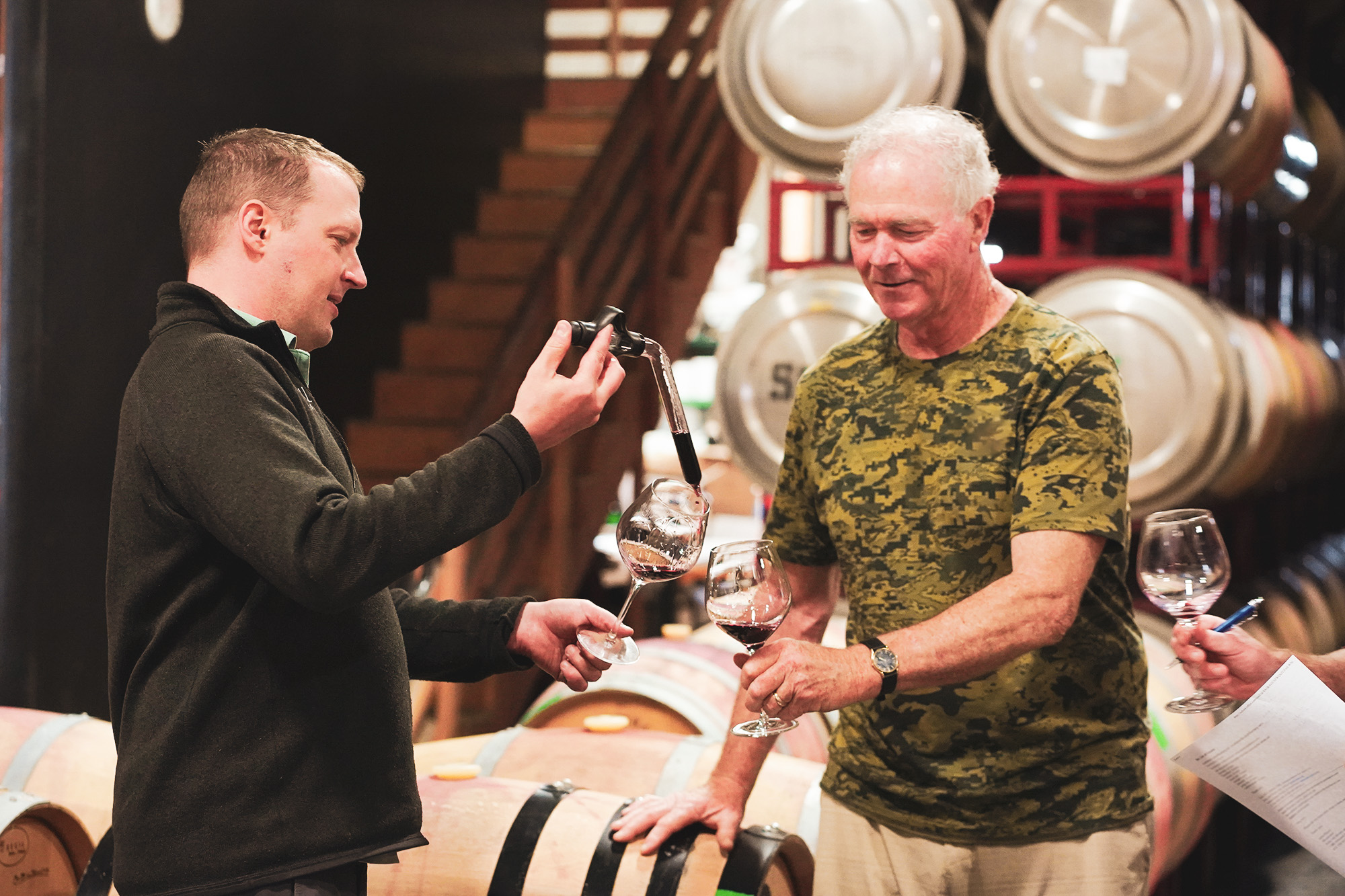
Futures Night is this weekend! This ticketed member-exclusive event will feature barrel tastings of 7 phenomenal Rubino Estates and Ruby Hill Wines. We are delighted to share the barrels that have been hand-selected for Futures Night by our talented team. Guests of the event will have the opportunity to taste and pre-order these gorgeous wines!
Rubino Estates Riserva Sangiovese
Estimated bottling date: June 2024
Enjoy the bright red fruit character of this Italian classic! Our Riserva Sangiovese brings lively notes of cherry, strawberry, and raspberry to the palate, along with excellent food-friendly acidity. A light touch of tannin on the palate leads into a fruity, vanilla-accented finish after time in oak. Our Sangiovese is rustic, robust, and gorgeous, perfect at pizza night and elegant dinners alike.
Rubino Estates Club Exclusive Ferrario
Estimated bottling date: June/July 2024
Enjoy a very rich and brooding aroma, with notes like chocolate, red fruit, plum and fig. Once barrel aging is complete, the palate releases a symphony of flavor, joined by a big mouthfeel, smooth tannins, and some spice. This wine was named in honor of Ernest Ferrario, an Italian immigrant, and proprietor of our Estate Vineyard from 1921-1975. Our winemaker crafted this wine exclusively for members of the Rubino Estates Wine Club.
Rubino Estates Landmark Proprietary Red
Estimated bottling date: February 2025
Our rich and lush Proprietary Red is a favorite of many guests and members, with saturated and bright flavor. This top-secret blend is comprised of our most exceptional varietals from each vintage. The exact components are known only to our winemaker, who has crafted this unique wine especially for you! After barrel aging, the finished wine is bold and gorgeous with promise to age gracefully.
Ruby Hill Reserve Cabernet Sauvignon
Estimated bottling date: July 2024
An undeniable classic, the Ruby Hill Reserve Cabernet Sauvignon is a stunner, vintage after vintage. Richly flavorful with a heavy and satisfying mouthfeel, you can expect a voluptuous profile on the palate and long, lingering finish. Flavors like marionberry, French plum, dark chocolate, black pepper, and vanilla bean are all at home in our estate vineyard's Cabernet Sauvignon. This Bordeaux beauty is known for its excellent ageability, so it can be enjoyed for years to come.
Ruby Hill Club Exclusive Patchwork
Estimated bottling date: June/July 2024
The Patchwork is named for the bird's-eye view of the vineyard, where each varietal block is stitched into a gorgeous patchwork of vines. The Patchwork's merry trio of varietals: Zinfandel, Merlot, and Petit Verot, create an elevated and enrapturing blend. Expressive Zin notes meet the darker and satisfying Merlot textures, along with plum notes, smooth tannin, and balanced acidity supported by the Petit Verdot elements.
Ruby Hill Jewel Petit Verdot
Estimated bottling date: February 2025
Luxe and refined, Petit Verdot offers elegance and richness, with notes of violet, berries, and lilac. As it ages, the subtleties develop into a multisensory symphony of flavor and texture. The Jewel Collection Series represents the epitome of winemaking at Ruby Hill, and our Petit Verdot puts that on display with pride. Crafted with attention to every detail and meticulous care for the farming, gentle vinification, and extended aging in carefully selected cooperage, this elegant wine is one to remember.
Odyssey, Chapter 3
Estimated bottling date: February 2025
This mysterious and ultra-exclusive wine is premium in every way. Odyssey is a red wine blend, made with the highest degree of care and opulence to celebrate the rich history and legacy of our estate. Each vintage corresponds to a chapter in our story. The 2020 vintage debuted as Chapter 1, and this barrel of 2022 Odyssey provides a glimpse at Chapter 3. You don't want to miss this.
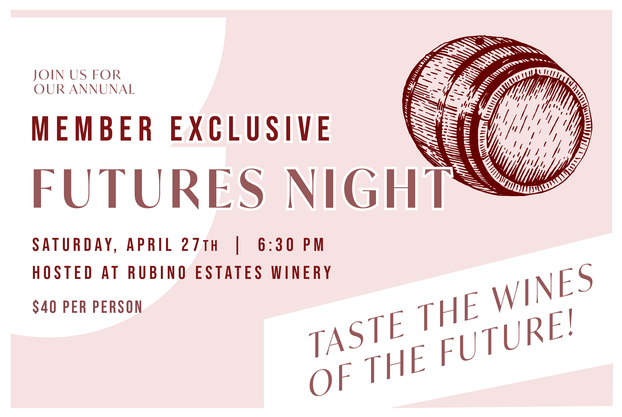
Click here to get your last-minute tickets to Futures Night!
Your Guide to Wine Futures
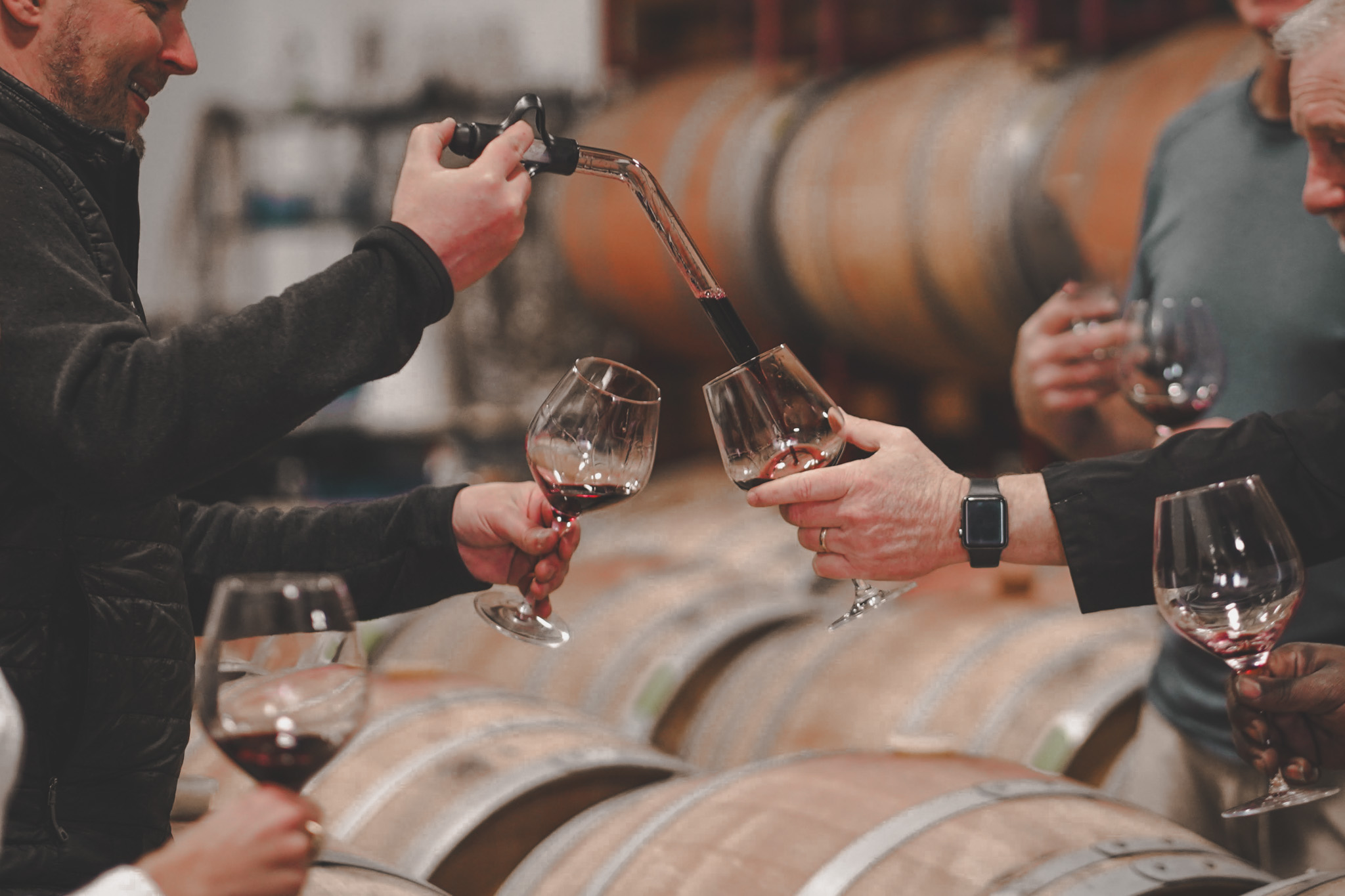 With Futures Night coming up in just two weeks, we are taking some time to explore the interesting and important aspects of wine futures barrel tastings, how they work, and how they differ from other barrel tasting.
With Futures Night coming up in just two weeks, we are taking some time to explore the interesting and important aspects of wine futures barrel tastings, how they work, and how they differ from other barrel tasting.
What are Wine Futures?
Wine futures are wines that have been blended into their final form but have not yet been bottled. This is distinct from other barrel tastings, wherein you try a single varietal from a single barrel. Single barrels like those become the components of a larger lot, which our winemaker will balance with additions from other barrels and even other varietals prior to bottling. This is the stage for Futures tasting. Though they are nearly ready to be bottled, there is still an element of youth to wine futures. In Bordeaux, wine futures are referred to as “en primeur” which translates to “in youth.” Wines sold en primeur may be bottled months or years after tasting from the barrel. Once bottled, the wines will be available to those who purchased.
How do you get the wine out of the barrel?
Oxidation caused by extended contact with air is the enemy of wine, so it is important to keep barrels sealed off. Barrels are made up of oaken slats, called staves, one of which has a hole for access. These holes are stopped up with a rubber plug called a “bung” to protect the wine inside from the air. To sample the futures inside the barrels, we use a device called a “wine thief,” a tubular pipette designed to perfectly “steal” tastes of wine from the barrel.
What is different about a wine future and how is the wine going to change?
One of the reasons for extended barrel aging is to allow oak character to balance the fruit and to give the natural tannins time to integrate. Tasting wine futures allows you to appreciate the character of the fruit itself, which lays the foundation for the eventual wine’s overall profile. Tasting futures is a great way to put your palate to the test and gain intimate insight into the process of your favorite wines. If you like it in the barrel, imagine it in the bottle! Futures allow you to preview and buy what you’ll really love.
Why buy a future wine?
If you want to secure access to limited edition wines that sell out fast, this is your chance! Some vintages are gone before you know it, and buying futures assures the chance to have these wines won’t pass you by. Even more, when you purchase a future, you are purchasing far below retail value. Think of it as an investment! Futures also offer the unique chance to buy something now that will mature and come to fruition later, making it perfect for milestone celebrations like birthdays, anniversaries, promotions, and retirement.
Who can buy wine futures
In classic Bordeaux futures tastings, these exclusive pre-sales are open to a select few importers, journalists, retailers, and critics. Here at the Rubino Estates, we are opening our barrels for one night only to our beloved Club Members! We want to share our futures with wine lovers who know that the best things in life are worth waiting for. Our Futures Night will be hosted Saturday, April 27th, and will feature some of the best wine futures from all over our Estate, including wines from Ruby Hill Winery. The event will be held in our tasting room.
Tickets must be purchased in advance and are on sale now! Click here. 
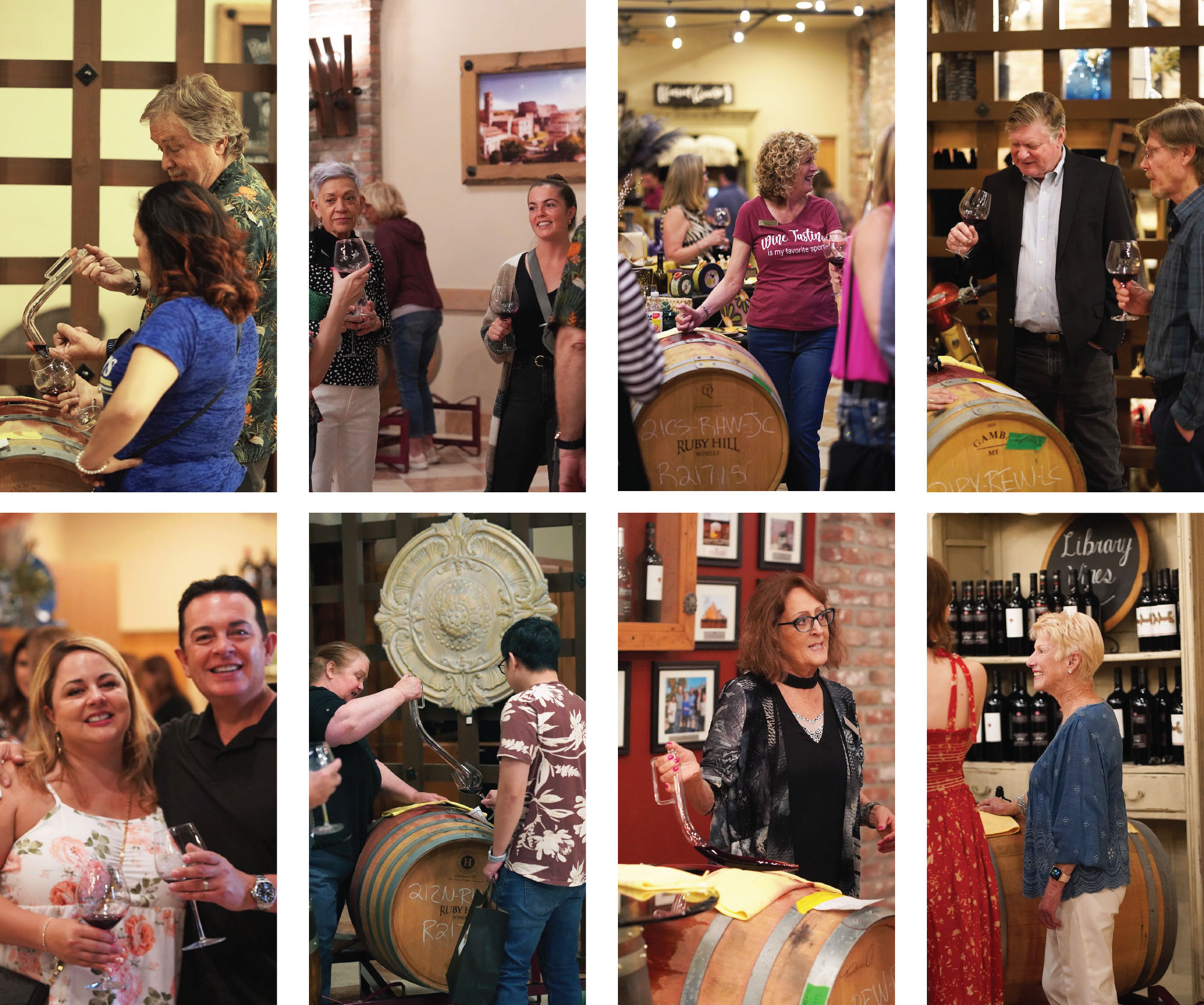
If you're not currently a member but would like to join us for Futures Night, now is the time to sign up! Click here for more information on the wine club.
9 Fresh Recipes for Springtime
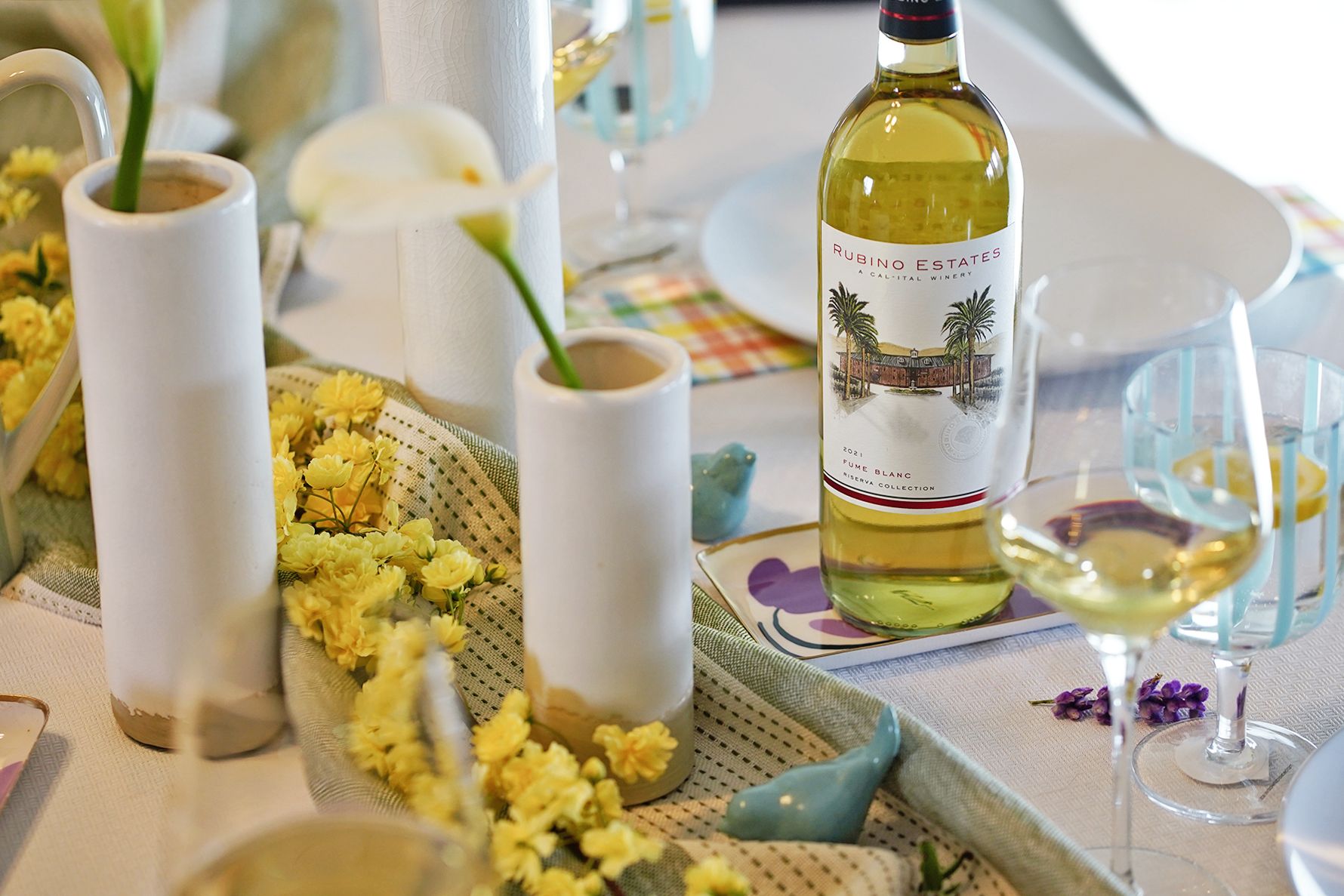
The signs of spring have descended upon the Estate, bringing irresistible freshness and a sense of complete renewal. We can’t get enough! This week, we were inspired by the crisp and pristine joy of spring to collect a few luscious recipes that celebrate the refreshing newness of this season. These entrees, mains, and desserts pair well with our favorite springtime wines, including lush white wines, lively rosé, and lighter reds.
Appetizers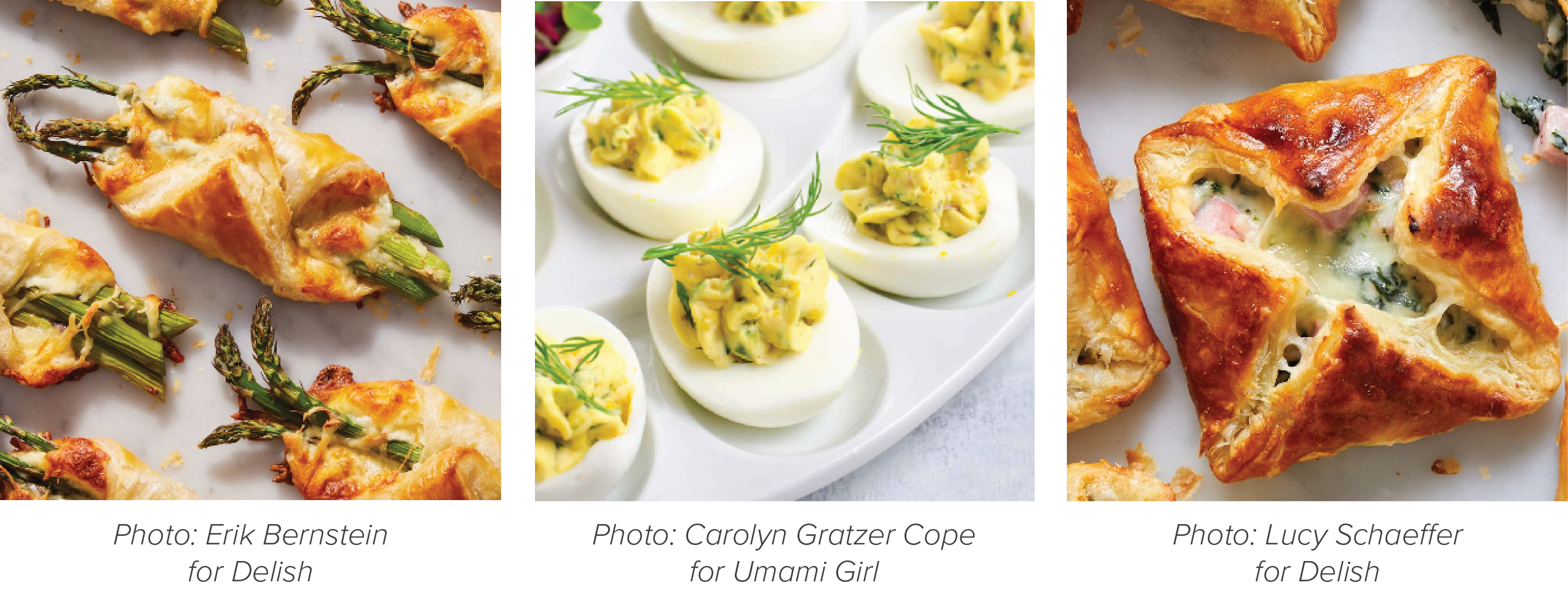
Asparagus Bundles - by Delish
These little beauties marry garden produce with comforting flavors, since we still have rainy days in spring! We can’t get enough of these perfectly balanced bites.
Herbed Deviled Eggs - by Umami Girl
It wouldn’t be springtime without some deviled eggs. Elevate this classic dish with fresh herbs to make a new Easter celebration staple!
Ham & Cheese Spinach Puffs - by Delish
These perfect little puffs bring a perfect combination of savory, salty, and creamy for a super satisfying and delightful morsel.
Mains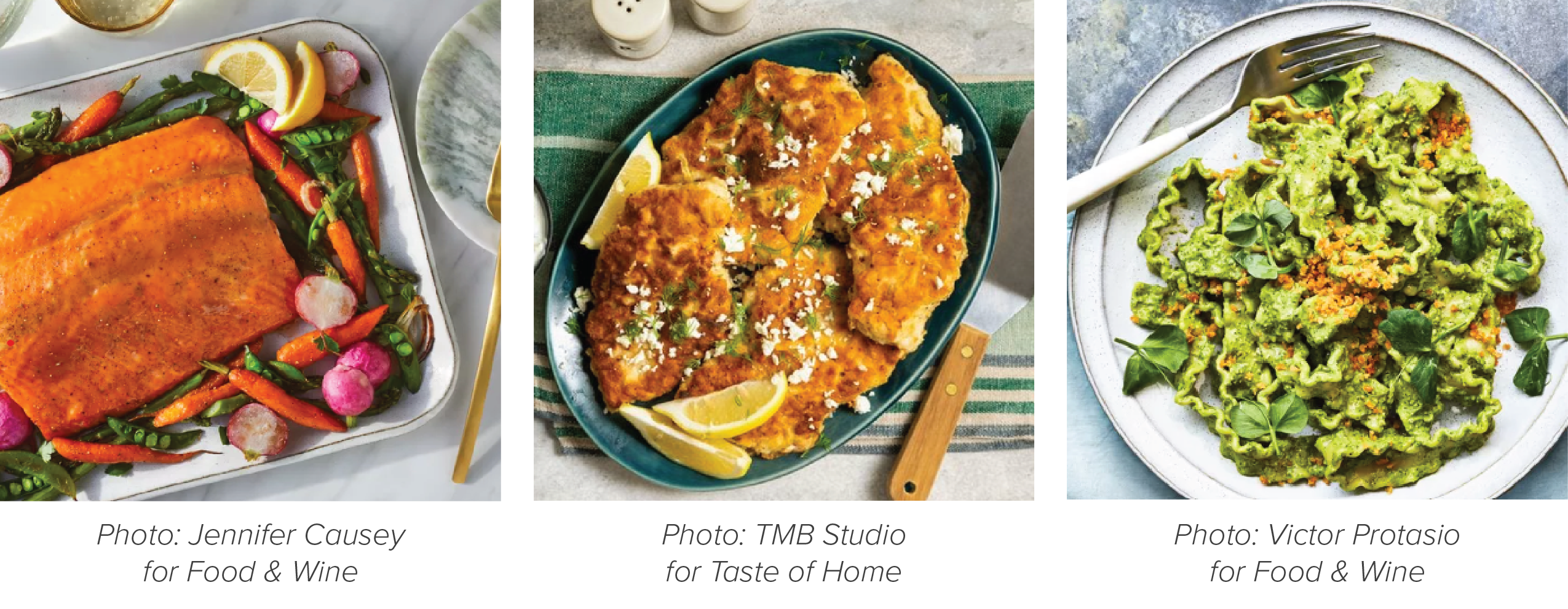
Roasted Salmon with Spring Vegetables - by Food and Wine
Sheet pan dinners simplify your evening, and with a recipe like this you will not feel like you are compromising. Versatile and nutritious!
Chicken Tzatziki - by Taste of Home
Another wholesome meal, this recipe offers a great balance of simplicity and satisfaction. You can customize the tzatziki to your flavor preferences, and put it on anything you like!
Mafaldine Pasta with Pea Shoot & Lemon Pesto - by Food and Wine
This vegetarian pasta bursts with all the best verdant freshness you could hope for. Frankly, we’re excited for any scratch-made pesto, and this is no exception.
Dessert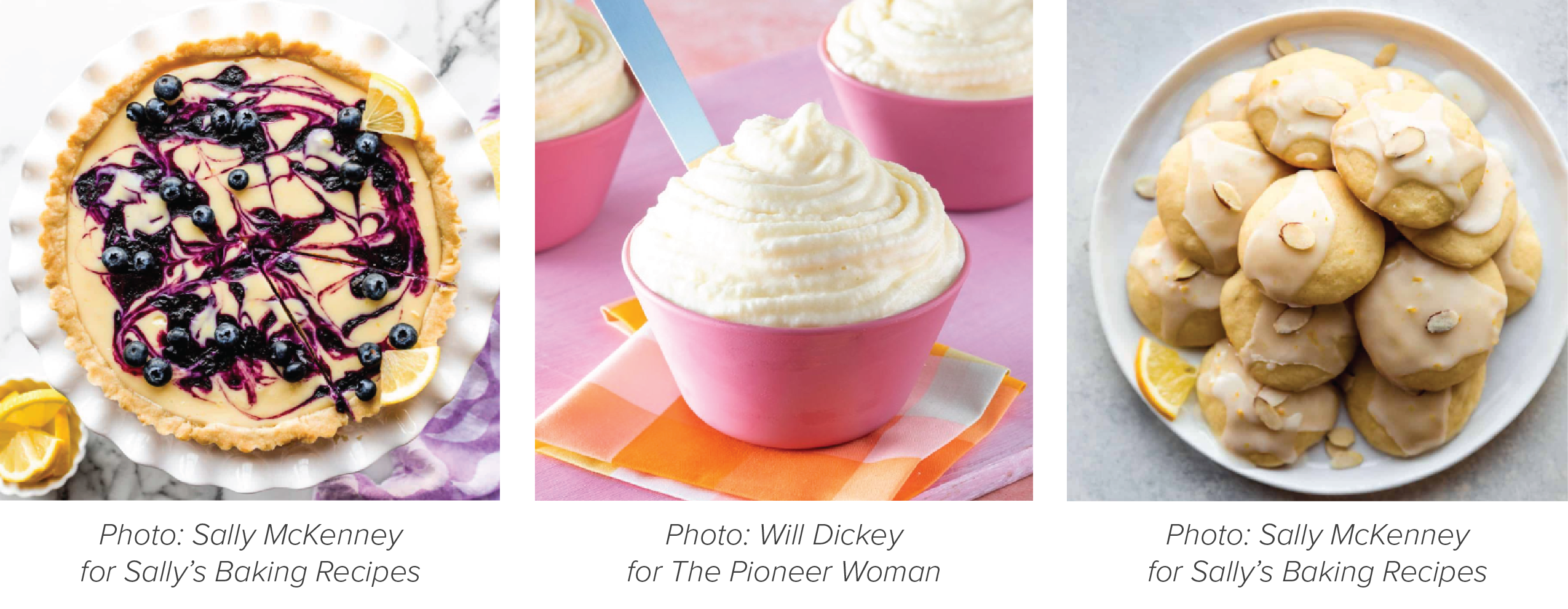
Lemon Blueberry Tart - by Sally’s Baking Recipes
If you’re never made a tart before, now is the time. The zip of lemon mixed with delectable blueberries will have you ready for another slice!
Pineapple Whip - by The Pioneer Woman
This soft-serve-like dessert has us longing for summer already! We find that it pairs perfectly with the tropical notes in our favorite white wines, so it’s never too early for this pineapple whip.
Lemon Ricottta Cookies - by Sally’s Baking Recipes
It’s hard to say no to a cookie like this. Fluffy and irresistible, these resemble madeleines and bring a perfect melt-in-your-mouth sensation. These can also be made with orange in place of lemon!
Pruning and Preparation: A Vineyard Update
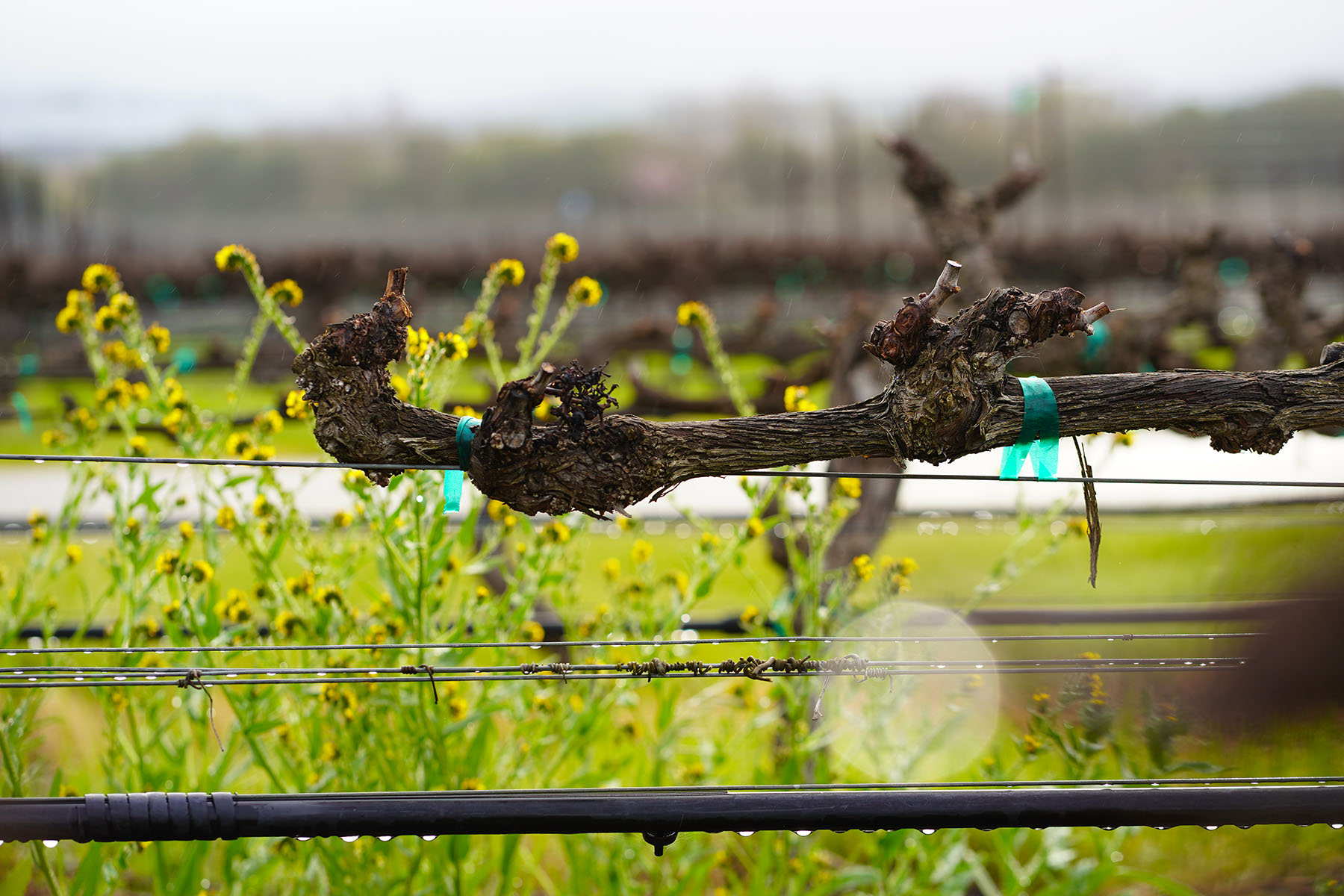 If you look out into the estate vineyard this time of year, it might not look like much. The branches are bare, the vines from last season are pruned away, and all signs of leaves and fruit are long gone. However, though dormancy is dreary on the outside, marvelous things are happening. Scroll through this gallery, taking a virtual walk with us as we ponder what makes this season special.
If you look out into the estate vineyard this time of year, it might not look like much. The branches are bare, the vines from last season are pruned away, and all signs of leaves and fruit are long gone. However, though dormancy is dreary on the outside, marvelous things are happening. Scroll through this gallery, taking a virtual walk with us as we ponder what makes this season special.
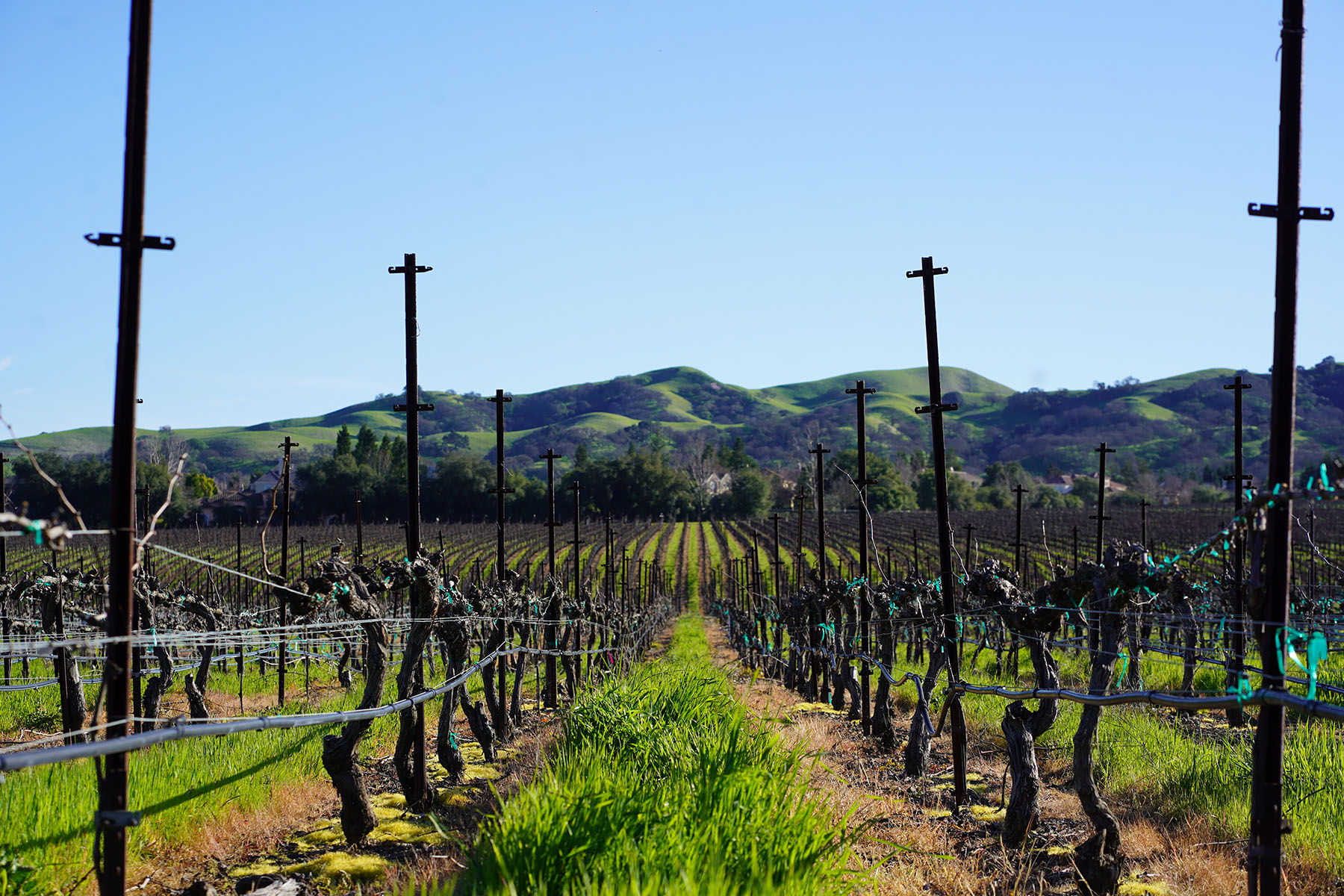 As winter gives way to spring, the vineyard begins to come to life.
As winter gives way to spring, the vineyard begins to come to life.
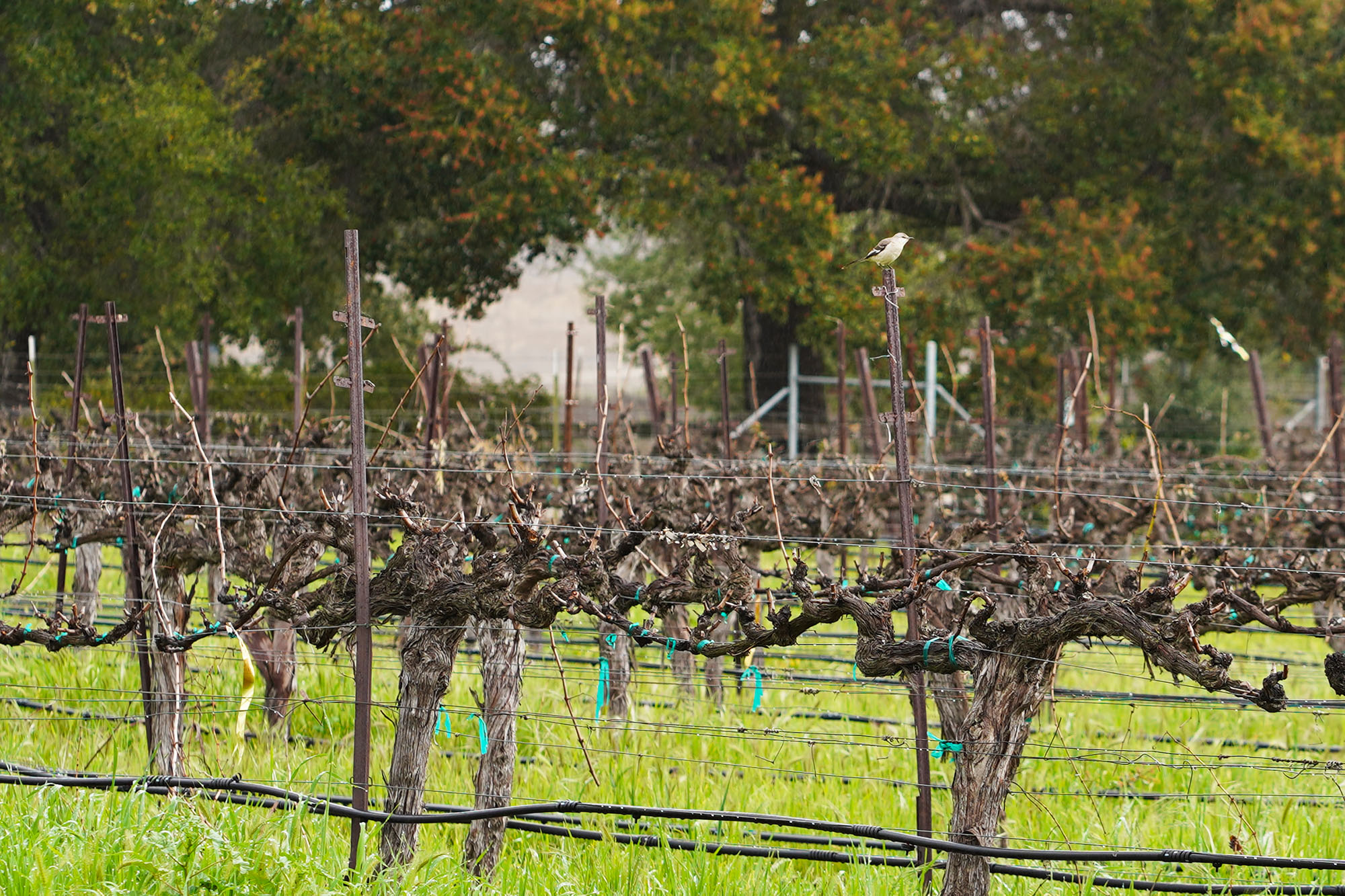 The telltale signs of springtime are starting to reach out over the estate, sprouting blossoms, blooms, and brightness.
The telltale signs of springtime are starting to reach out over the estate, sprouting blossoms, blooms, and brightness.
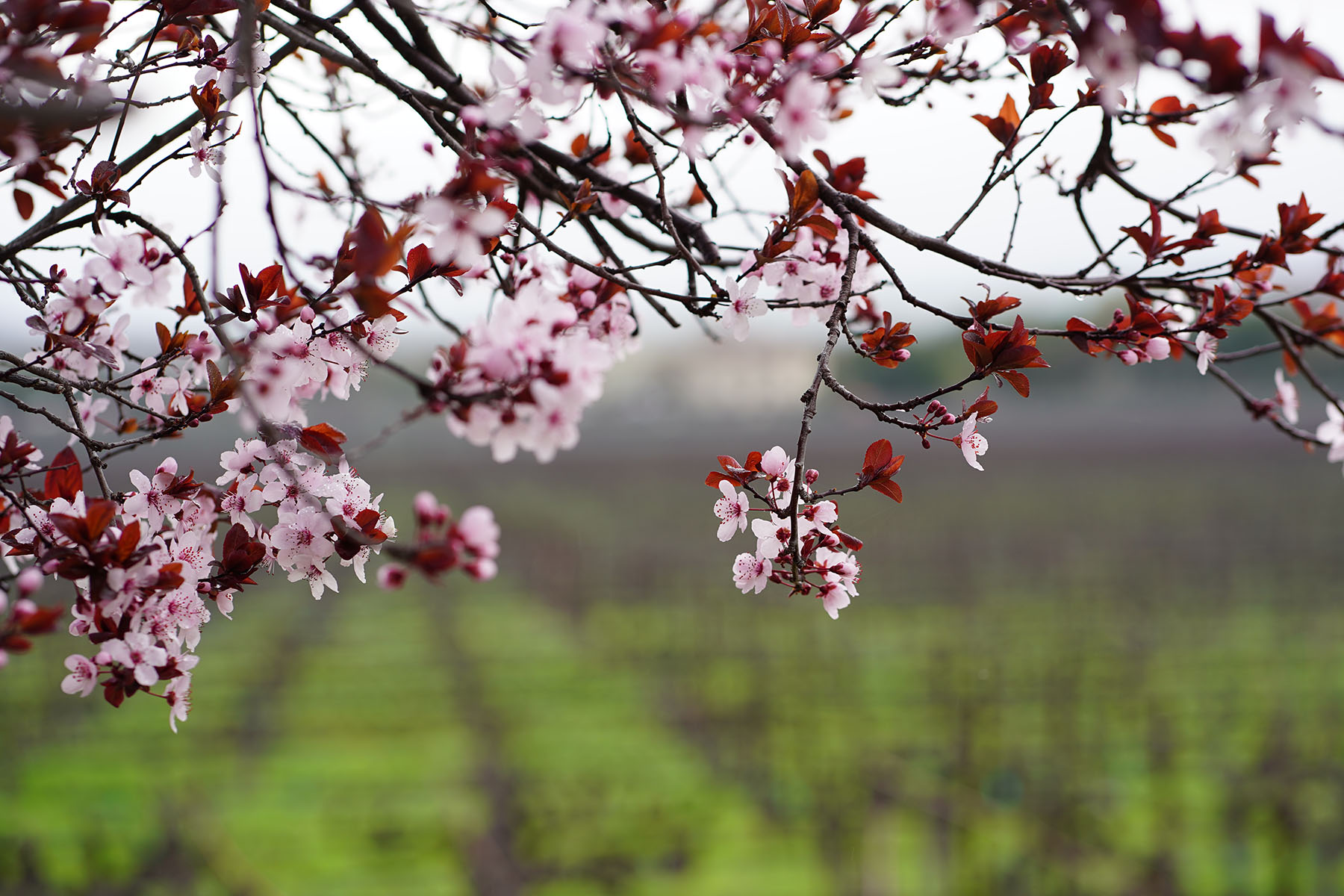 Lively splashes of color replace the dull tones of winter, providing just a hint of the vibrance to come.
Lively splashes of color replace the dull tones of winter, providing just a hint of the vibrance to come.
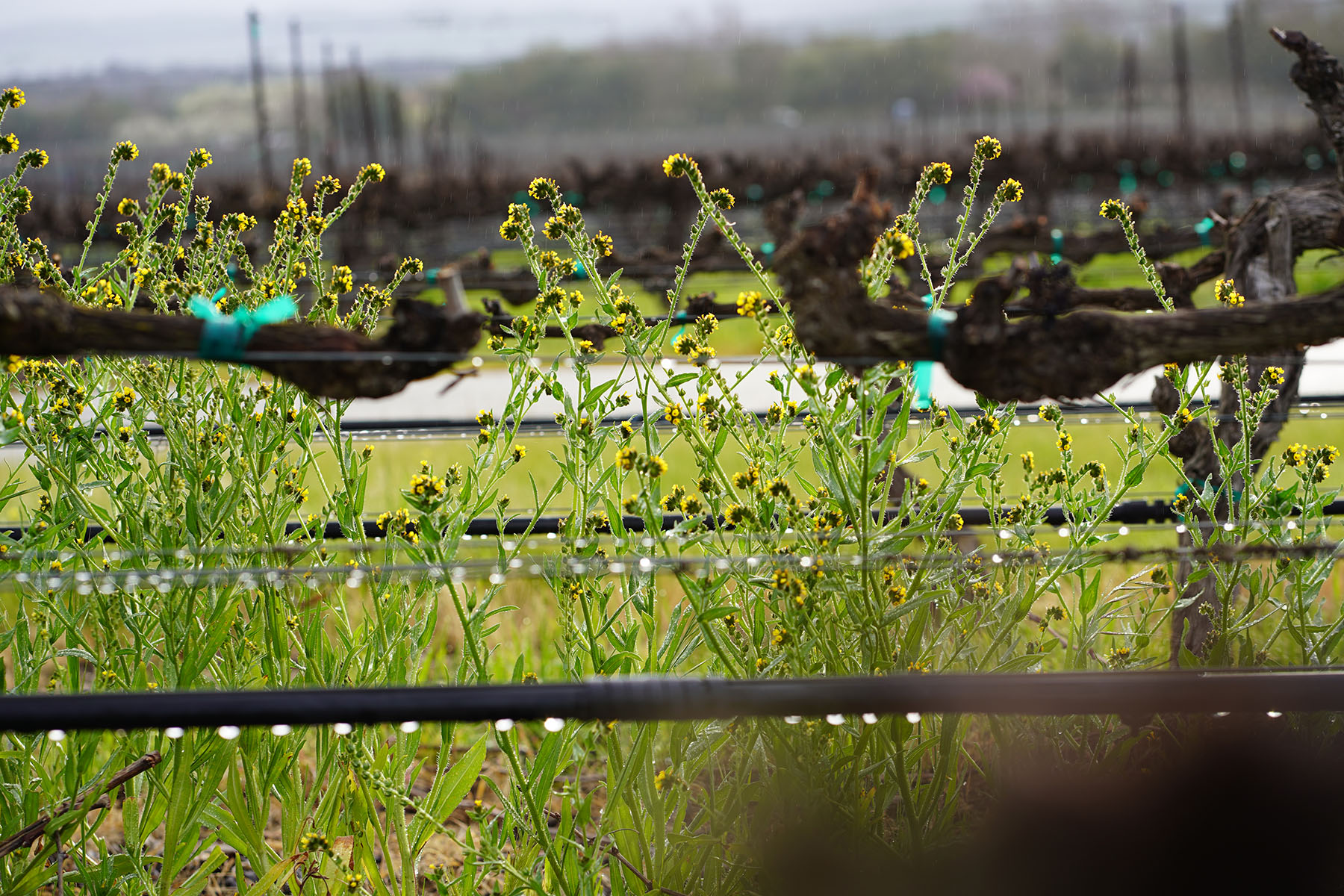 The faithful pattern of steady drizzle and dazzling sunshine sets us up for a fruitful and nurtured season.
The faithful pattern of steady drizzle and dazzling sunshine sets us up for a fruitful and nurtured season.
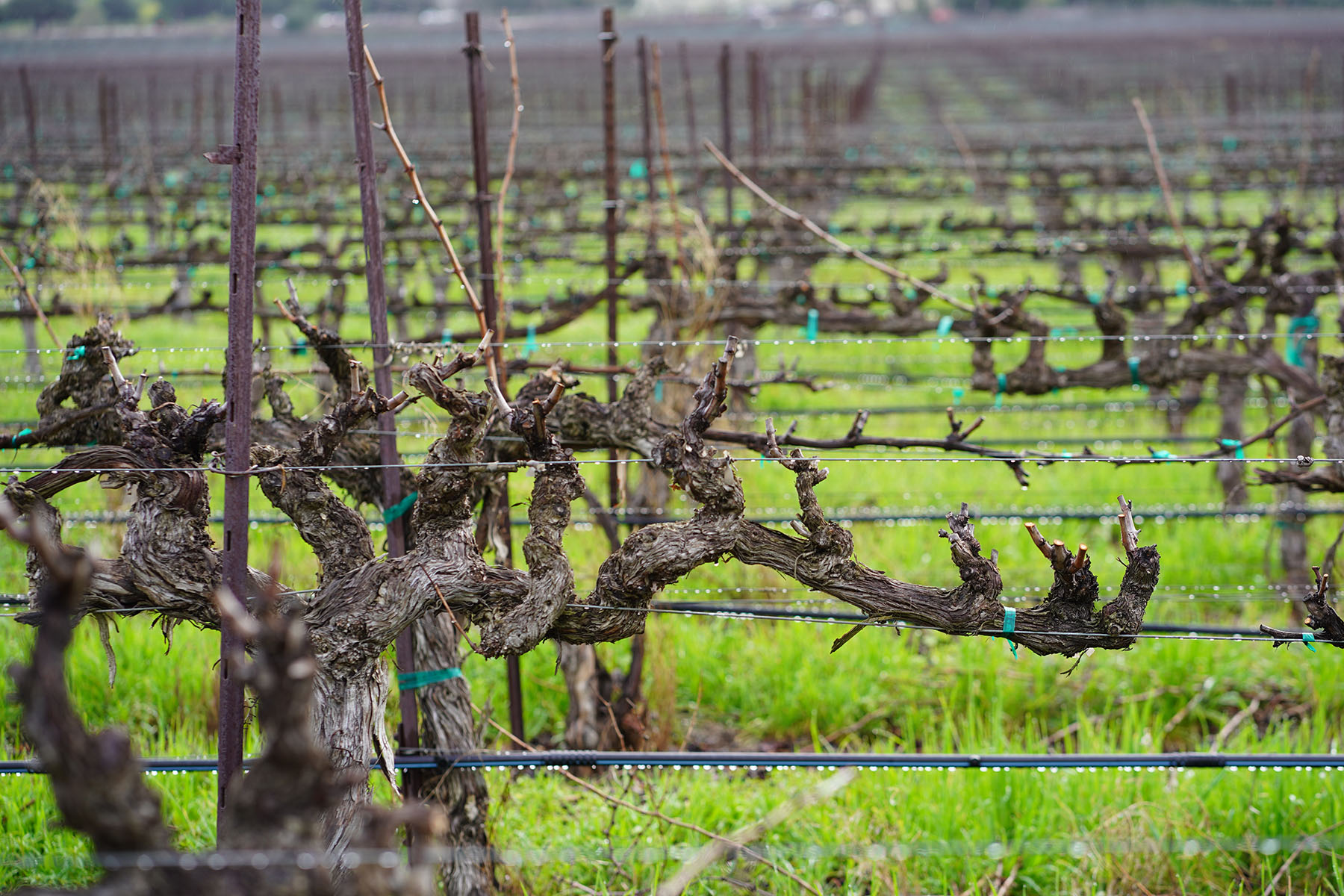 The rain makes everything lush and sparkly, the perfect complement to the sunshine that follows.
The rain makes everything lush and sparkly, the perfect complement to the sunshine that follows.
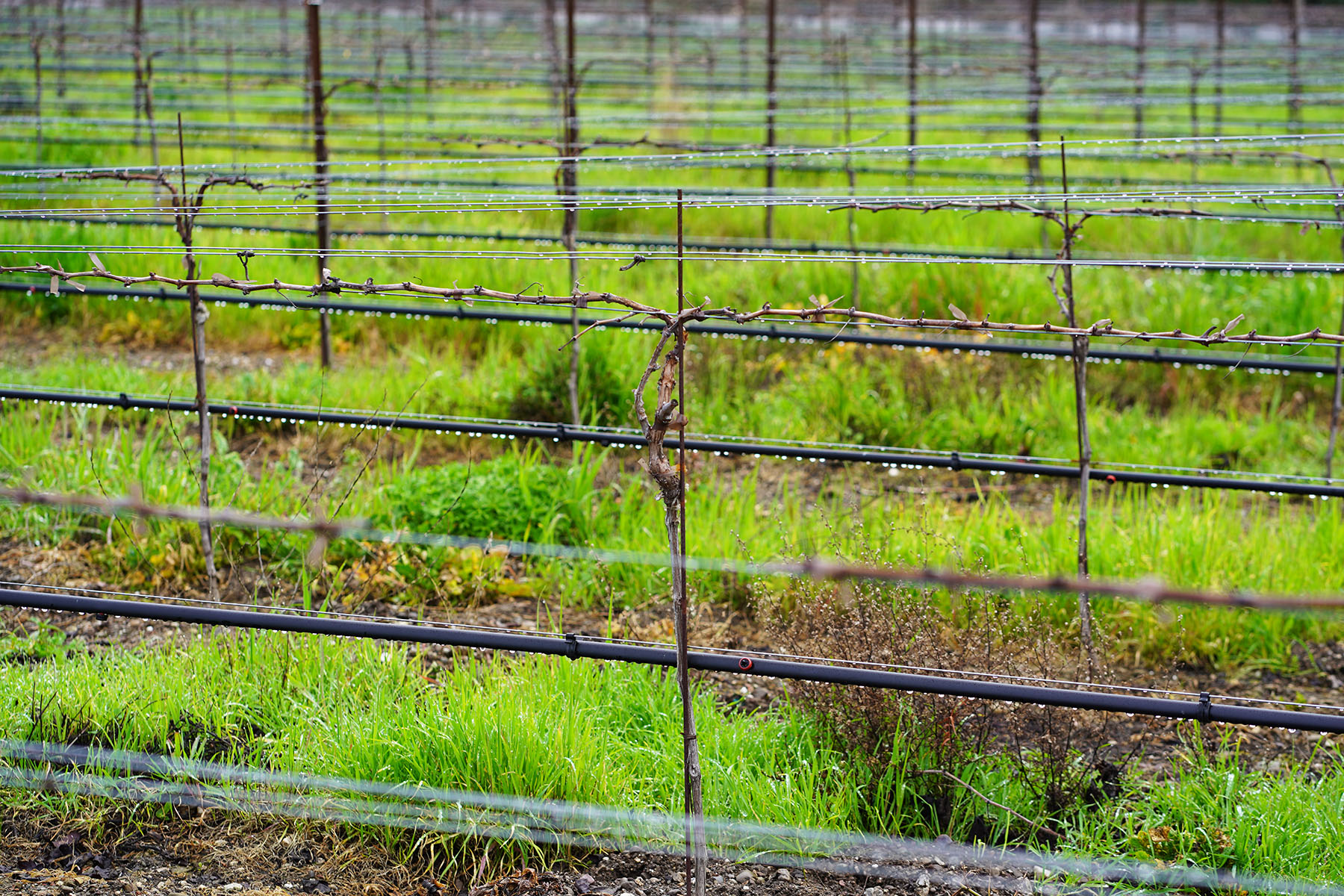 All of our vines, young and old, revel in these generous showers!
All of our vines, young and old, revel in these generous showers!
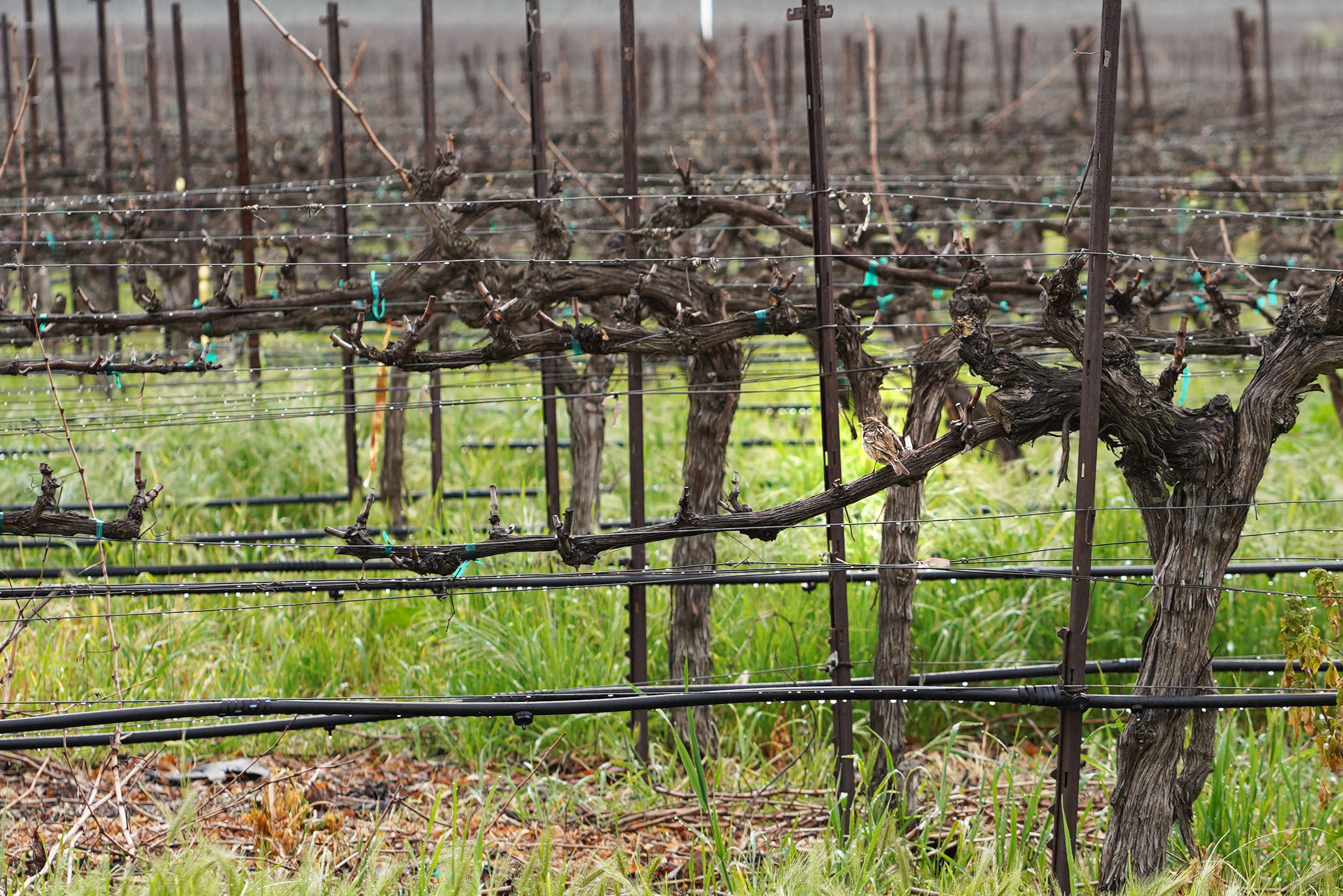 The next phase of the growing season is bud break, but some of our vines will remain dormant longer than others.
The next phase of the growing season is bud break, but some of our vines will remain dormant longer than others.
 After pruning, the vine will pull nutrients from the roots to flow through the whole plant. A keen eye on a sunny day may notice glistening droplets of sap falling from newly pruned branches.
After pruning, the vine will pull nutrients from the roots to flow through the whole plant. A keen eye on a sunny day may notice glistening droplets of sap falling from newly pruned branches.
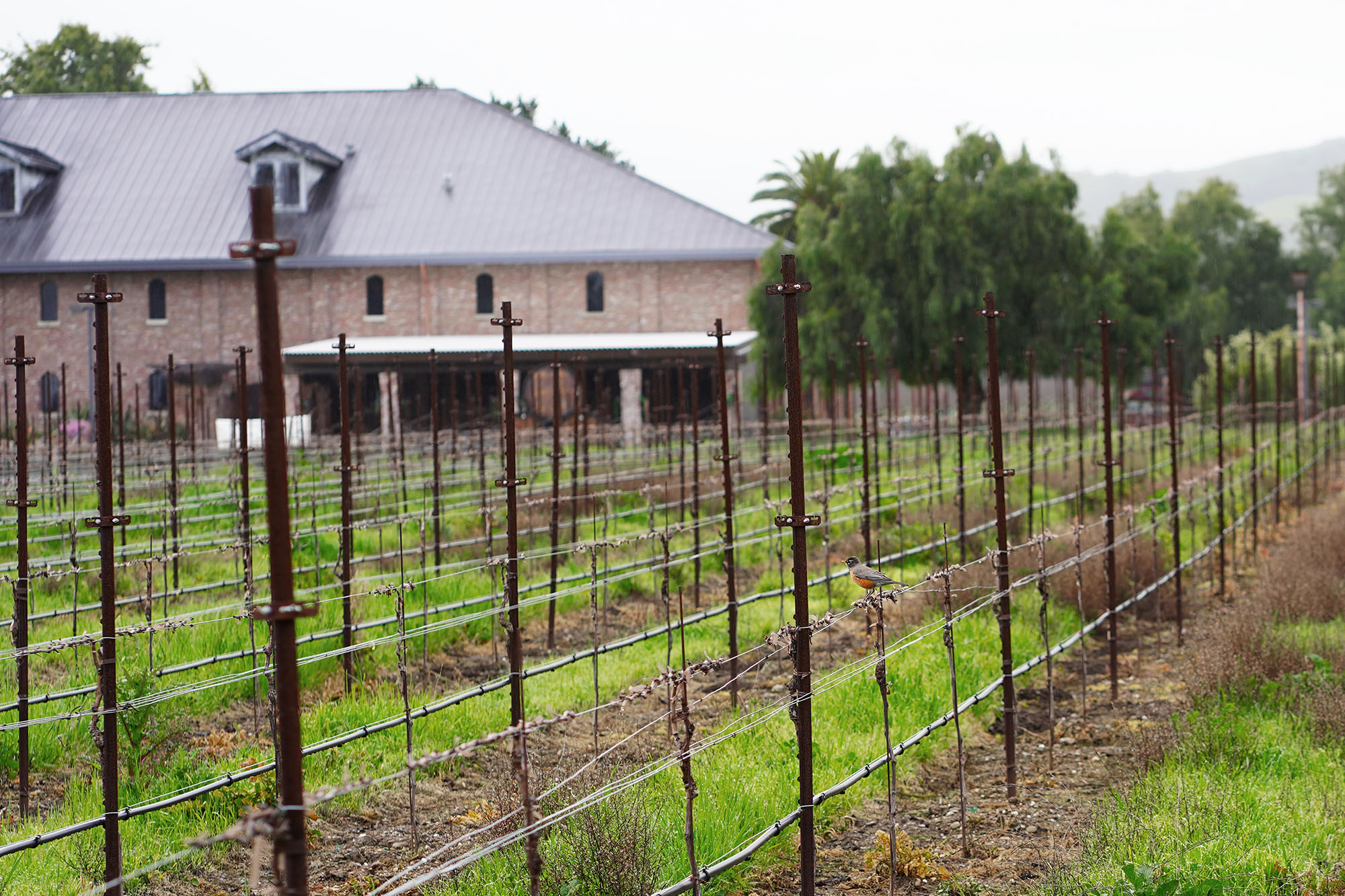 In preparation for the growing season, you may see that the branches are tied along wires in neat rows. This helps distribute the leafy growth, allowing the plant to catch as much sunshine as possible when the time comes.
In preparation for the growing season, you may see that the branches are tied along wires in neat rows. This helps distribute the leafy growth, allowing the plant to catch as much sunshine as possible when the time comes.
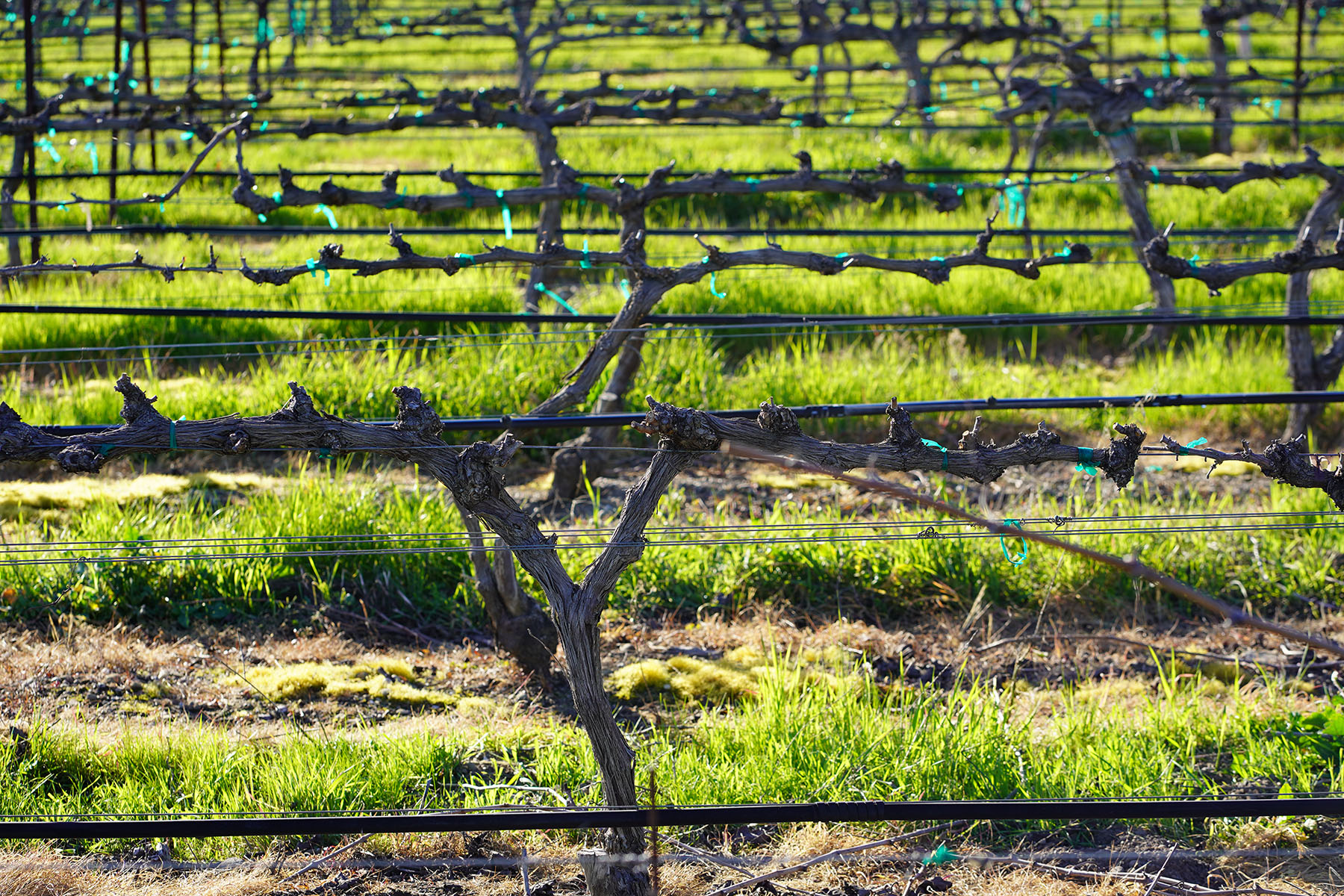 After pruning and before the growth of leafy canopy, you can easily see the row-by-row layout which shows the organized nature of the vineyard to allow for optimal care.
After pruning and before the growth of leafy canopy, you can easily see the row-by-row layout which shows the organized nature of the vineyard to allow for optimal care.
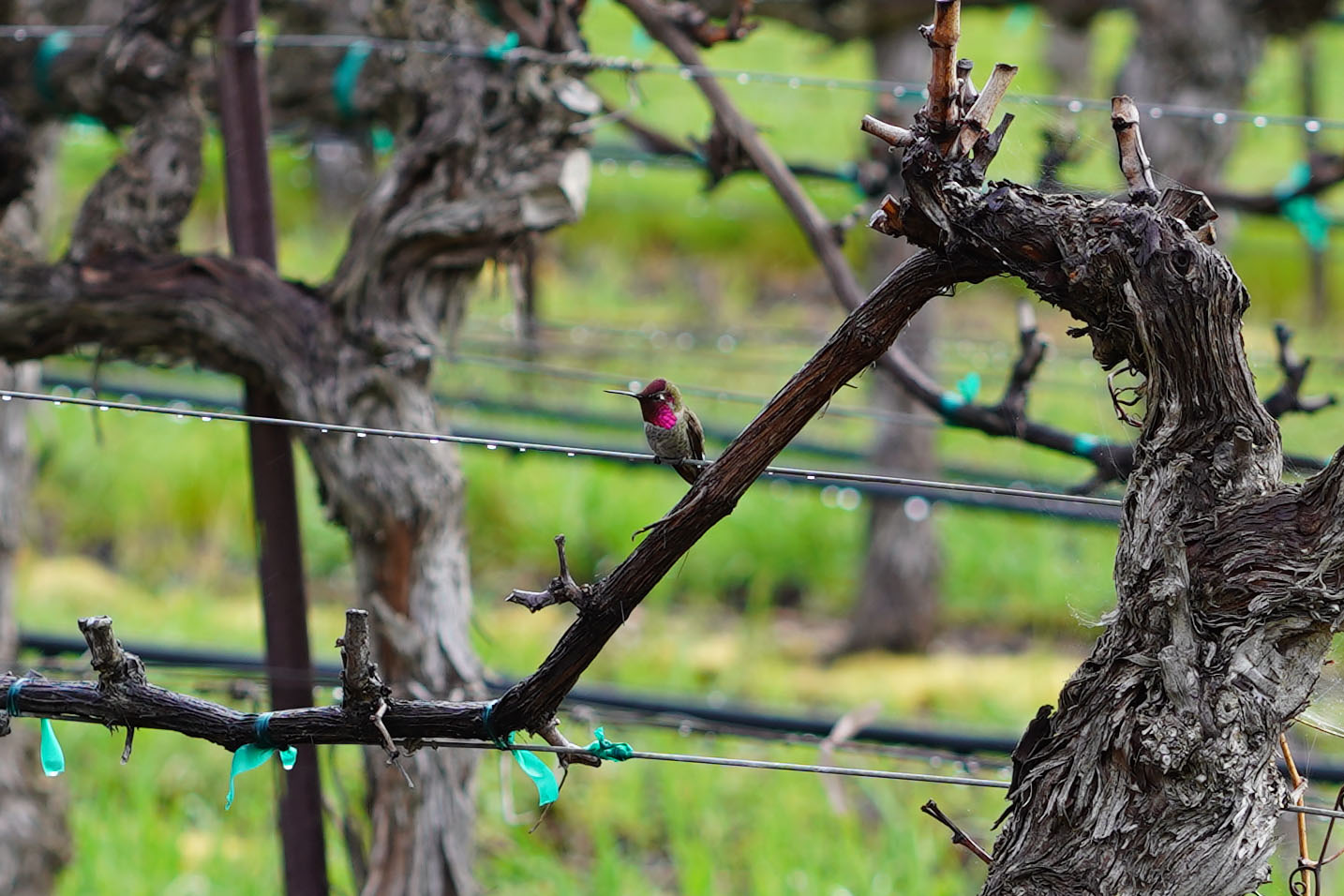 The whole estate is excited to welcome springtime!
The whole estate is excited to welcome springtime!
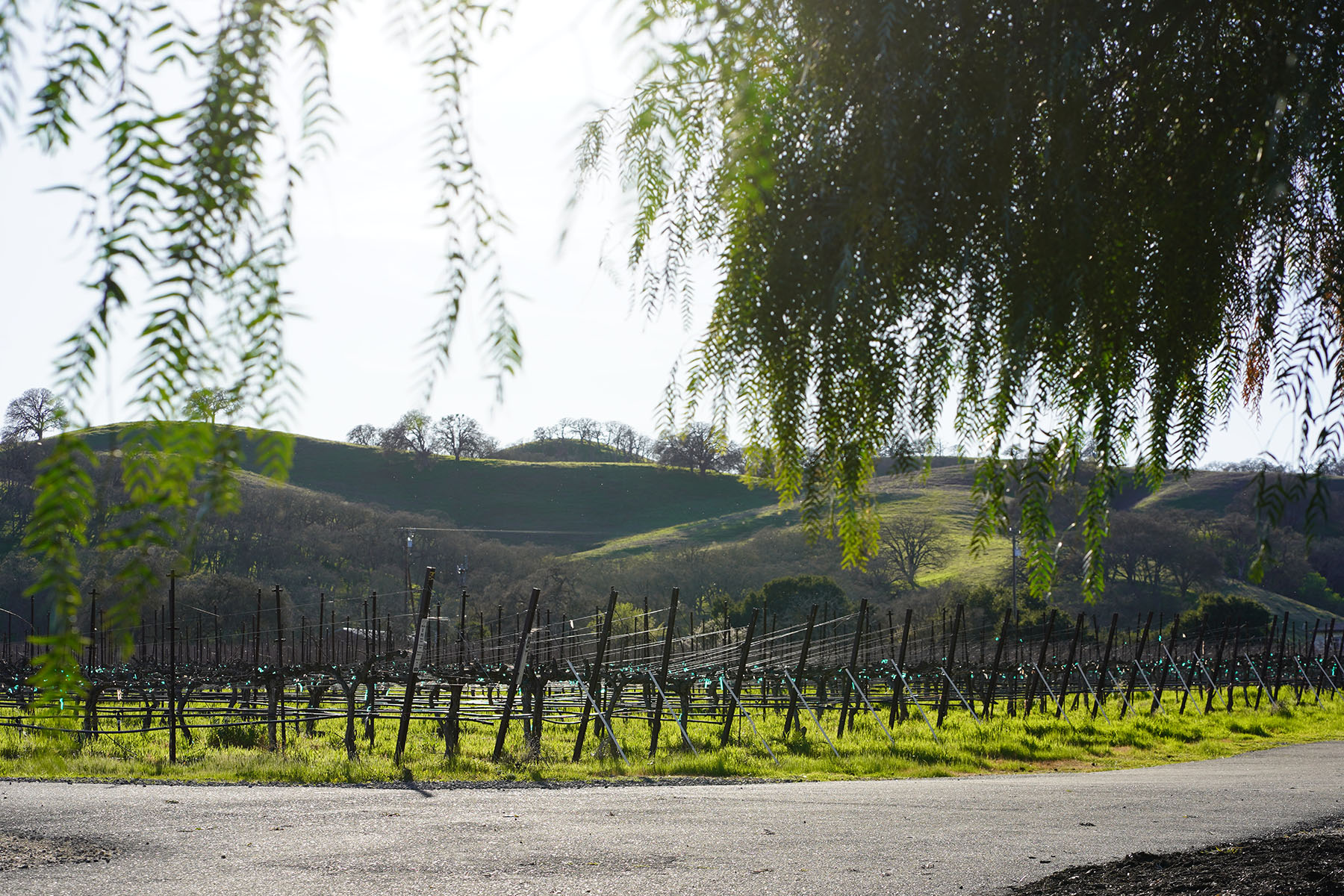 Come visit the estate and savor the beauty of this season. As always, we’re open seven days a week for indoor and outdoor wine tasting. Cheese!
Come visit the estate and savor the beauty of this season. As always, we’re open seven days a week for indoor and outdoor wine tasting. Cheese!
2024 Case Sale Blitz
This Weekend Only - March 9th & 10th 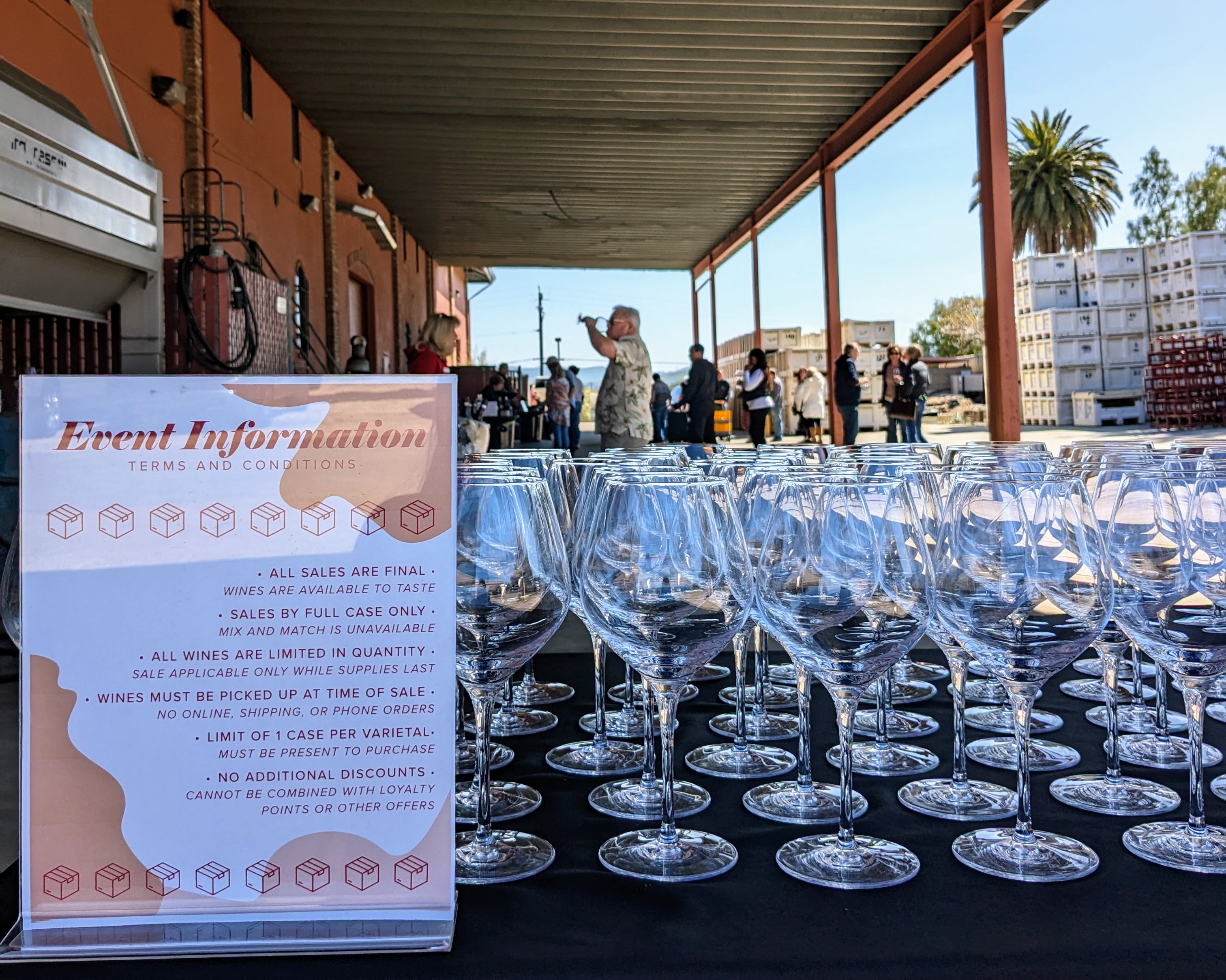 Our 2024 Case Sale Blitz is almost here! In this blog, you’ll find the juicy details on wines that we will feature in this year’s sale. Additional wines may make a surprise appearance, available in very limited supply, so don't miss out! More information about the event can be found at the bottom of this post.
Our 2024 Case Sale Blitz is almost here! In this blog, you’ll find the juicy details on wines that we will feature in this year’s sale. Additional wines may make a surprise appearance, available in very limited supply, so don't miss out! More information about the event can be found at the bottom of this post.
2017 Cabernet Sauvignon - Riserva Collection, Rubino Estates Winery
This wine was awarded Double Gold in the 2021 San Francisco Chronicle Wine Competition, and offers richly plush notes of black cherry, blackberry, and dark chocolate. The quintessential wine for a delicious steak dinner. We selected this vintage of Riserva Cabernet from the library and fell in love with the maturity and full-bodied nature of the tannin, with integrated roundness and just the right amount of ripeness.
Case Blitz Price: $210 | Member’s Price: $185
2018 Trebbiano - Rubino Estates Winery
This light and crisp varietal is a traditional Italian white wine. It is exceptionally prevalent in the old world, but a rare find here in California. A graceful yet subtle profile features notes of tart apple, white peach, orange blossom, and stone. On the palate, it is dry and delicate with pleasant food-friendly acidity, smooth sippable mouthfeel, and mild minerality. Pair with raw oysters with lemon or vinegar, fine white fish in lemon and butter sauce, summery pasta dishes, or uramaki sushi.
Case Blitz Price: $100 | Member’s Price: $75
2019 Ferrario - Famiglia Collection, Rubino Estates Winery
Velvety and elegant, each sip dances with jammy fruit and playful baking spice, all on a rich backdrop of floral accents. This wine is a club-exclusive blend, named in honor of Ernest Ferrario. Ferrario was an Italian immigrant and the proprietor of the Estate Vineyard from 1921-1975. By the mid-twentieth century, the Ferrario family was well-known for their quality wines, especially their Zinfandel. This blend honors the Ferrarios by combining Barbera—an Italian varietal, and Zinfandel—Ferrario’s specialty. The 2019 vintage components are 43% Zinfandel, 29% Barbera, 14% Merlot, and 14% Petit Verdot.
Case Blitz Price: $225 | Member’s Price: $200
2017 Petite Sirah - Reserve Collection, Ruby Hill Winery
This excellent Reserve Petite Sirah comes highly recommended, scoring 92 points by Wine Enthusiast. Jim Gordon, critic for Wine Enthusiast, summarized this bold beauty as such: “Big and opulent, this full-bodied wine is jam-packed with indulgent, ripe blackberry and blueberry flavors and braced with tons of fine-grained tannins for a mouthfilling and smooth texture.” You can expect tannin-endowed wines like these to only improve with age, so it’s the perfect time to open that 2017 and get lost in the luxury of each sip.
Case Blitz Price: $150 | Member’s Price: $125
2019 Cabernet Sauvignon - Reserve Collection, Ruby Hill Winery
Also awarded 92 points by Wine Enthusiast, this wine continues our reputation for phenomenal Cabernet. Multi-layered flavors include the dark fruit notes you can expect, including blackberry, black plum, black cherry, and cassis. Astute wine lovers can also search the aroma and flavors for accents of star anise, earthy forest floor, meaty umami, cedar, and a touch of sweet tobacco. Unctuous and smooth, this wine is perfect with a wide range of foods, and can be enjoyed now or for many years to come.
Case Blitz Price: $210 | Member’s Price: $185
Our Case Sale Blitz is our annual warehouse clear-out event, offering delicious wines at unbeatable prices so we can make room for the wines of the future! This event is hosted at Rubino Estates Winery in the covered production area around the back of the tasting room. All are welcome to attend this event at no cost, whether they are a first-time visitor or a long-time member of Ruby Hill or Rubino. No reservations are needed, just drop by, say hello, and try these featured wines!
The Case Sale Blitz will run from 11 a.m. to 5 p.m. on March 9th and 10th only. Sales are valid only while supplies last, and all wines are in limited quantity!
